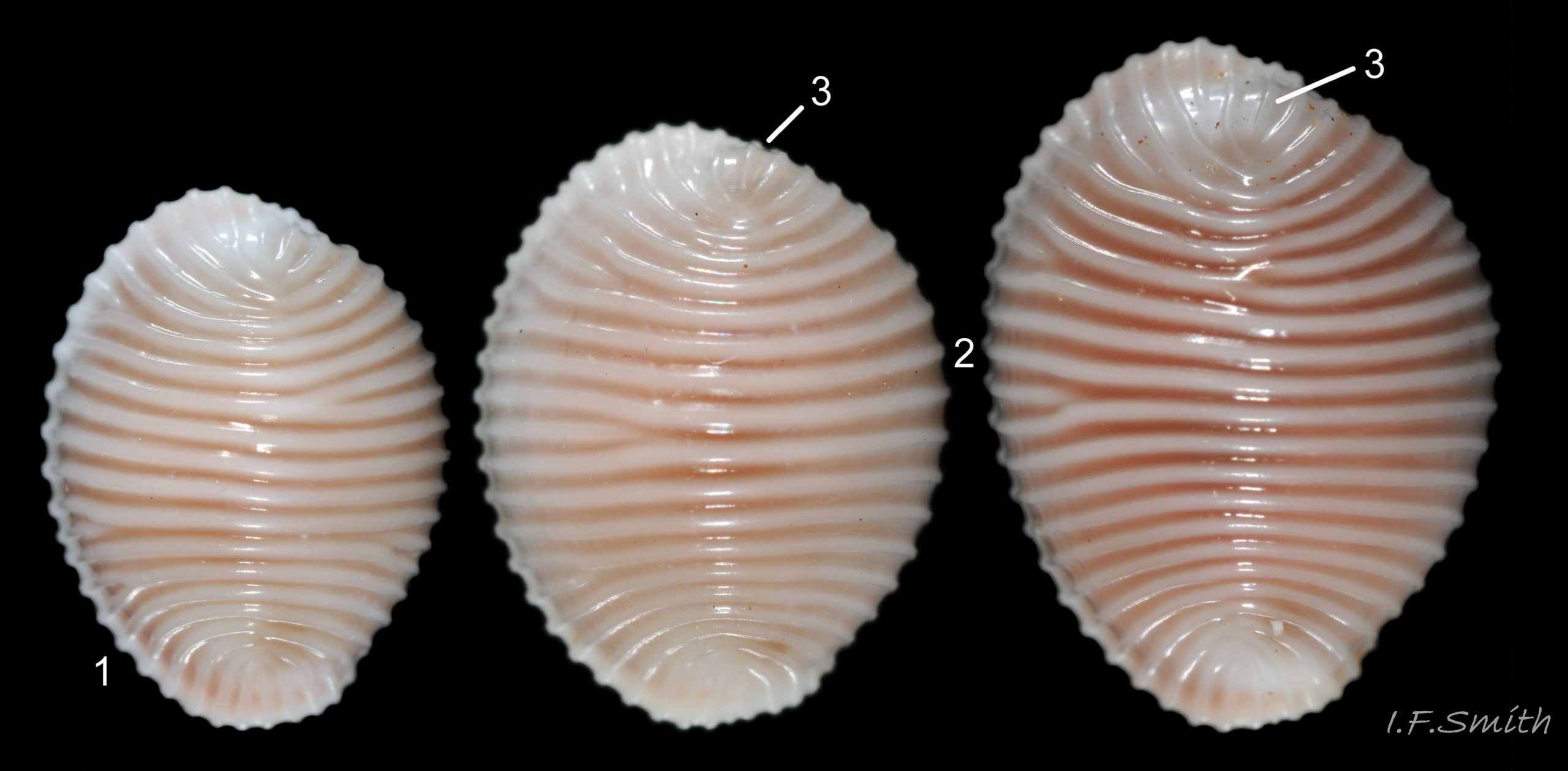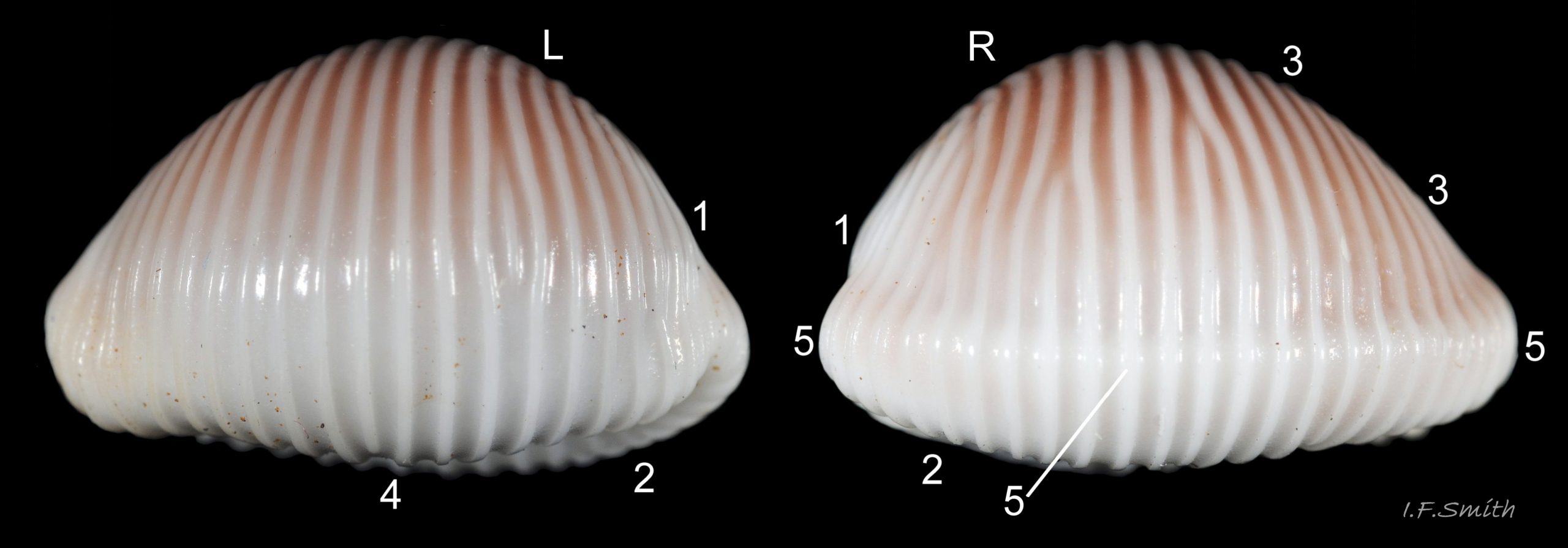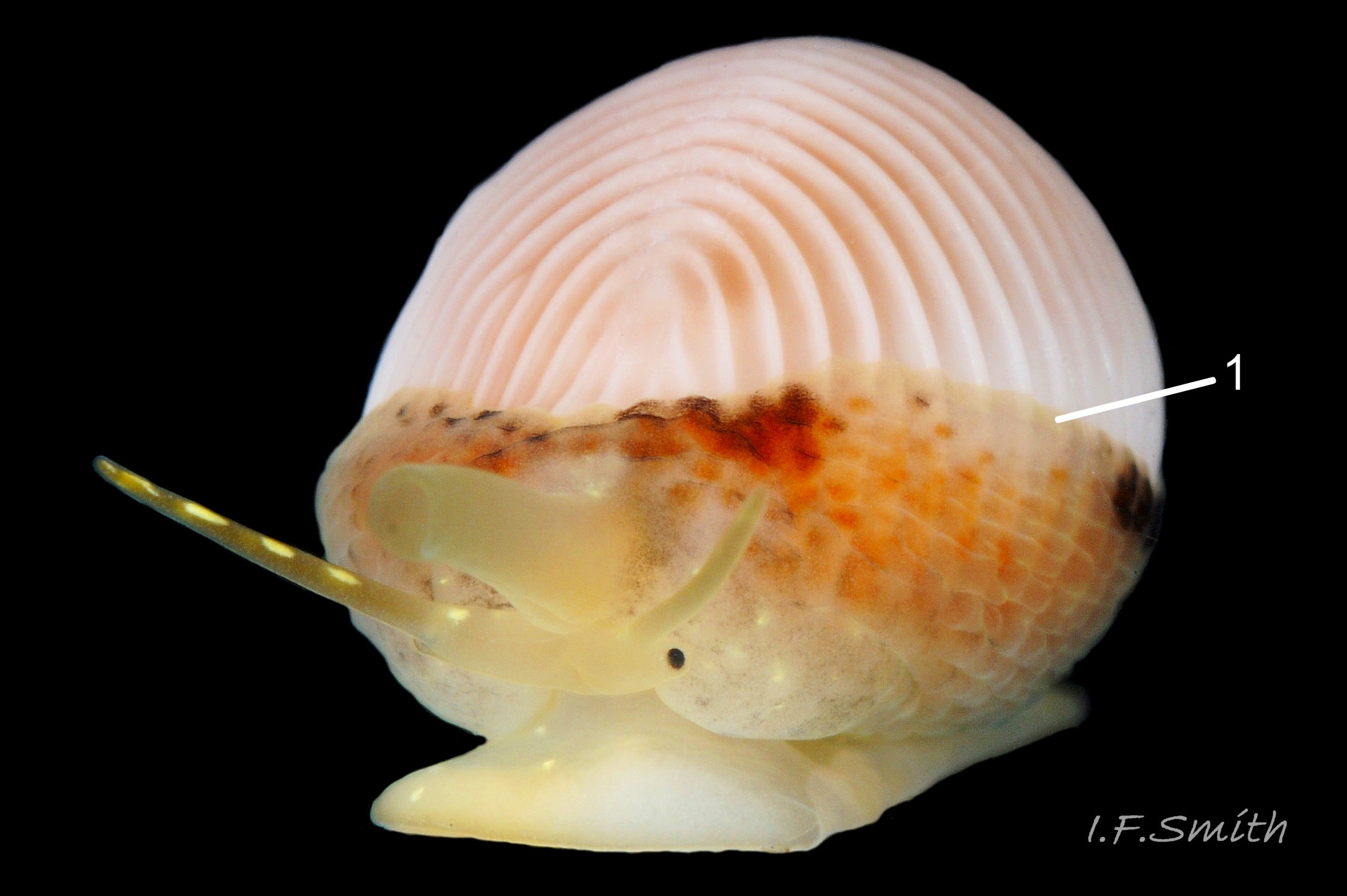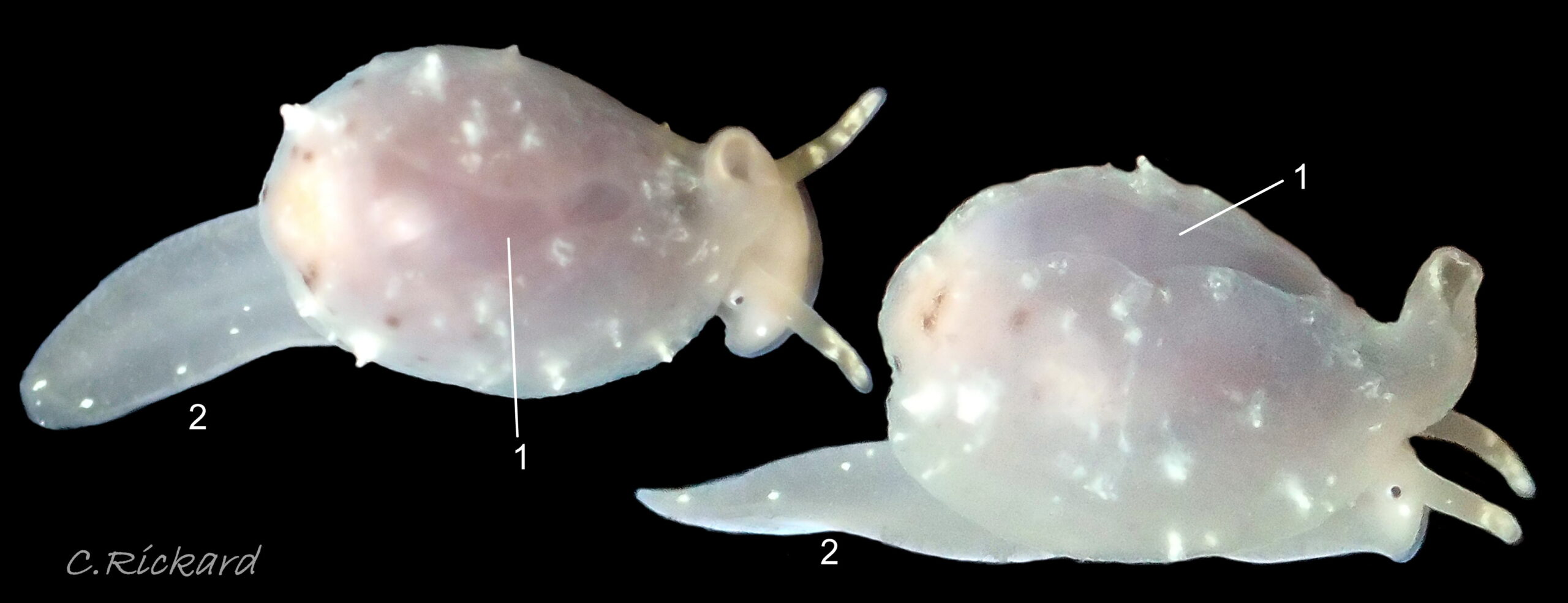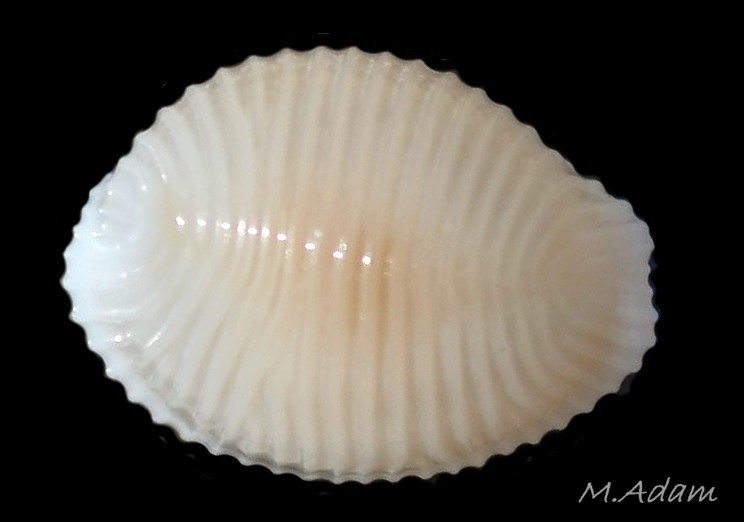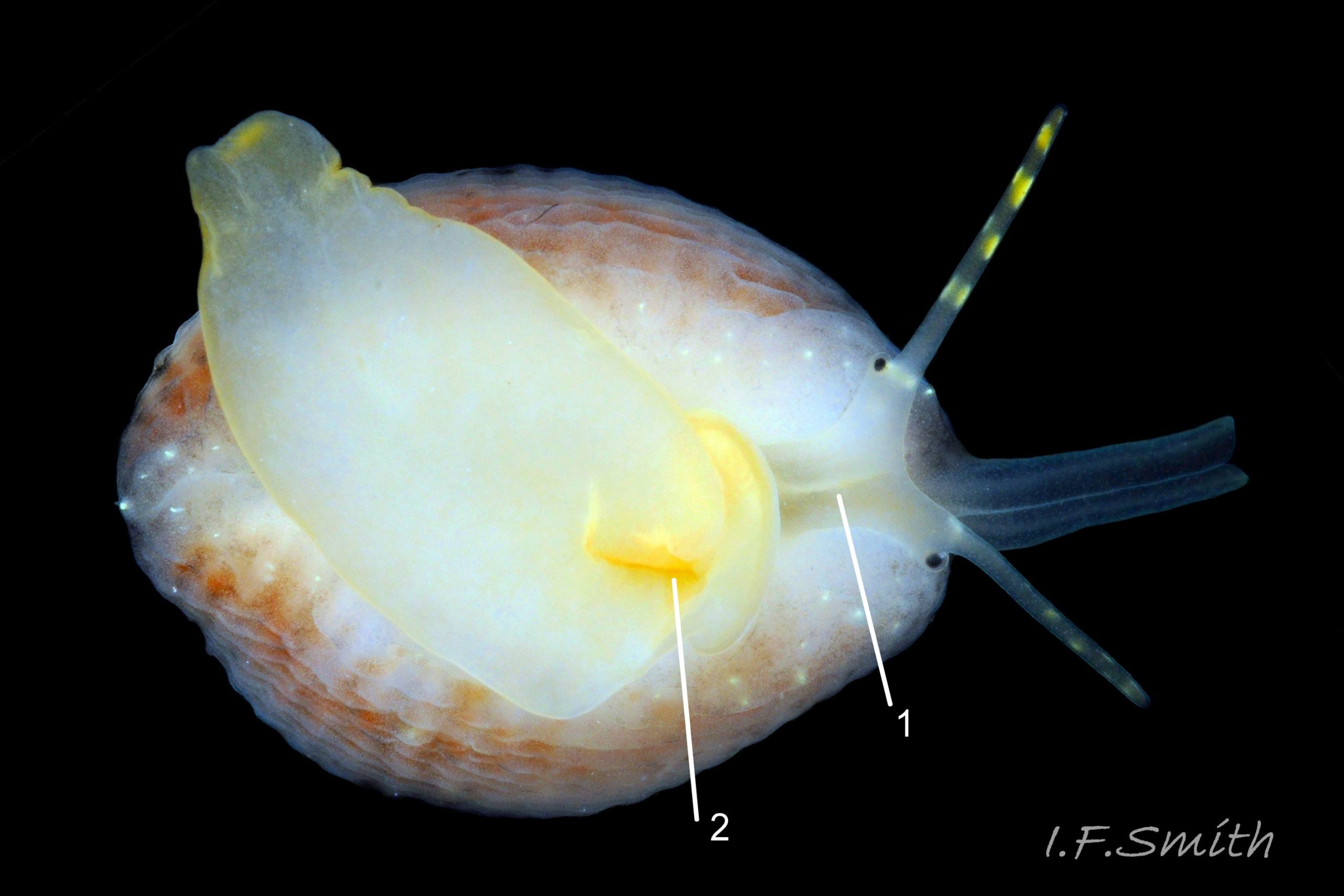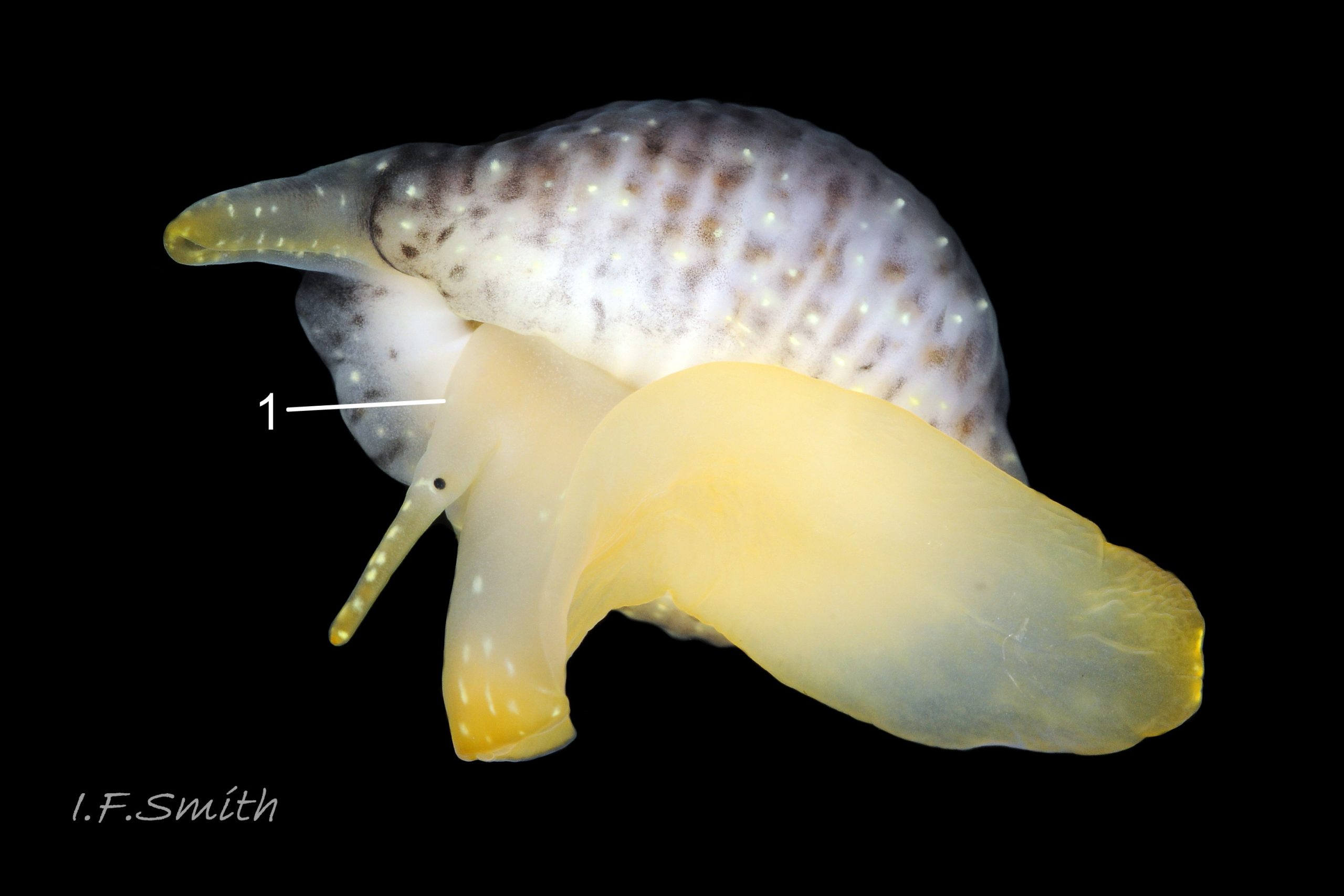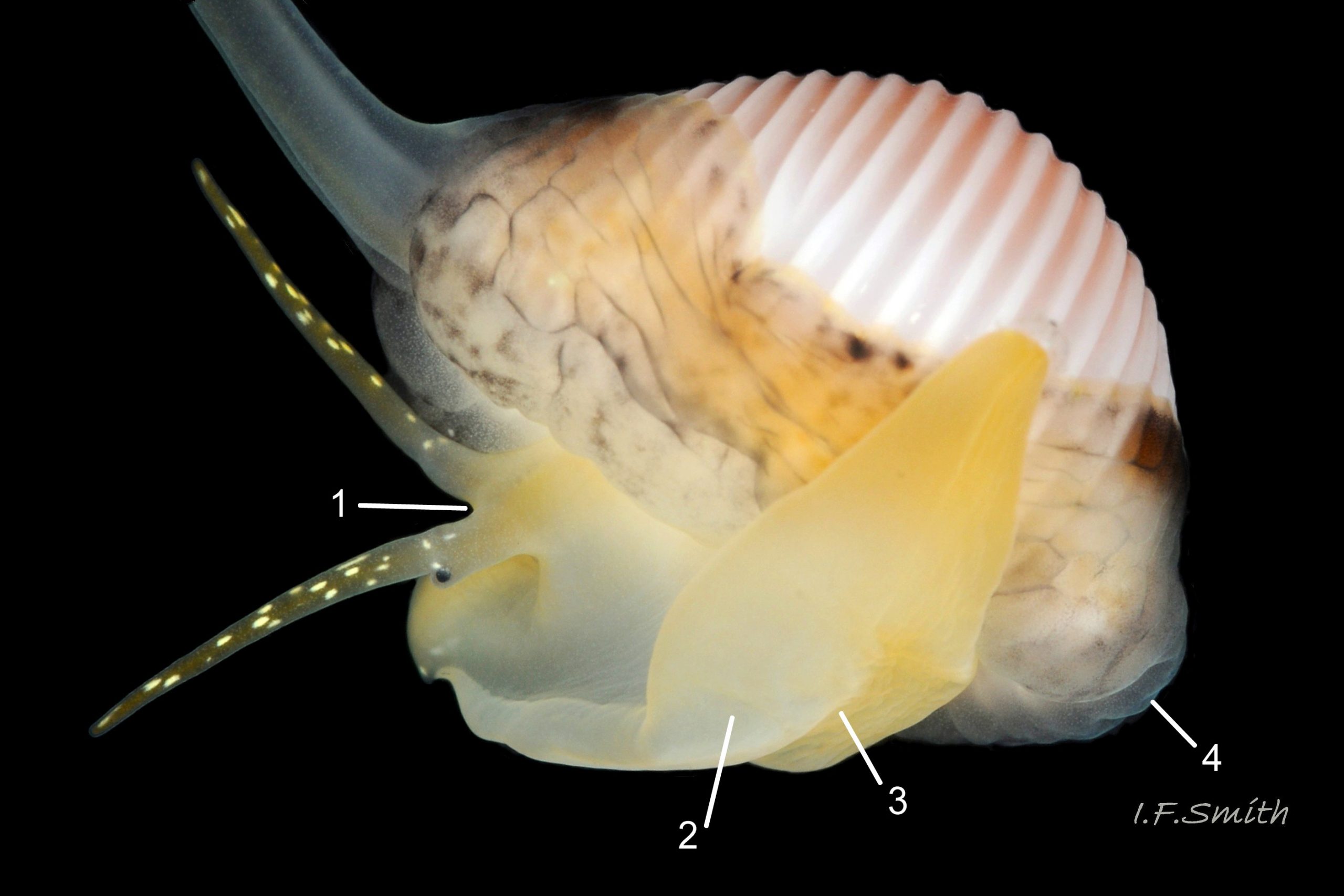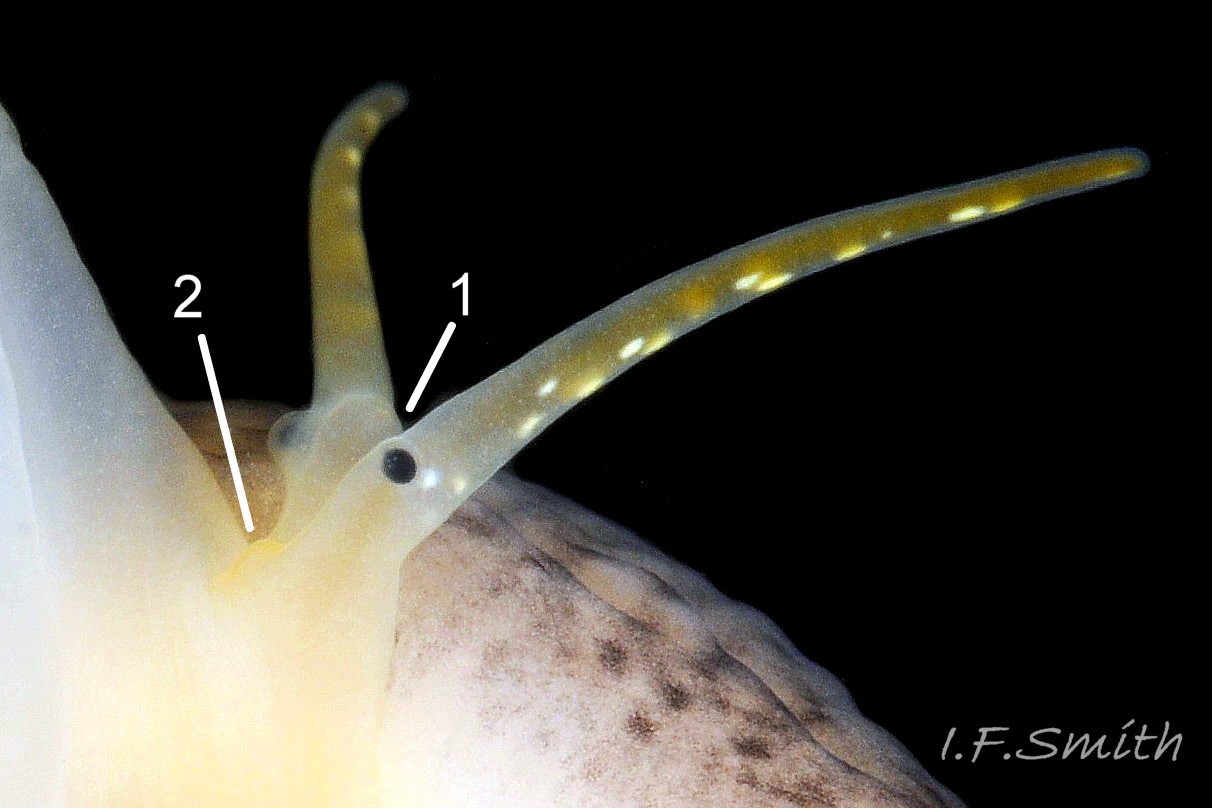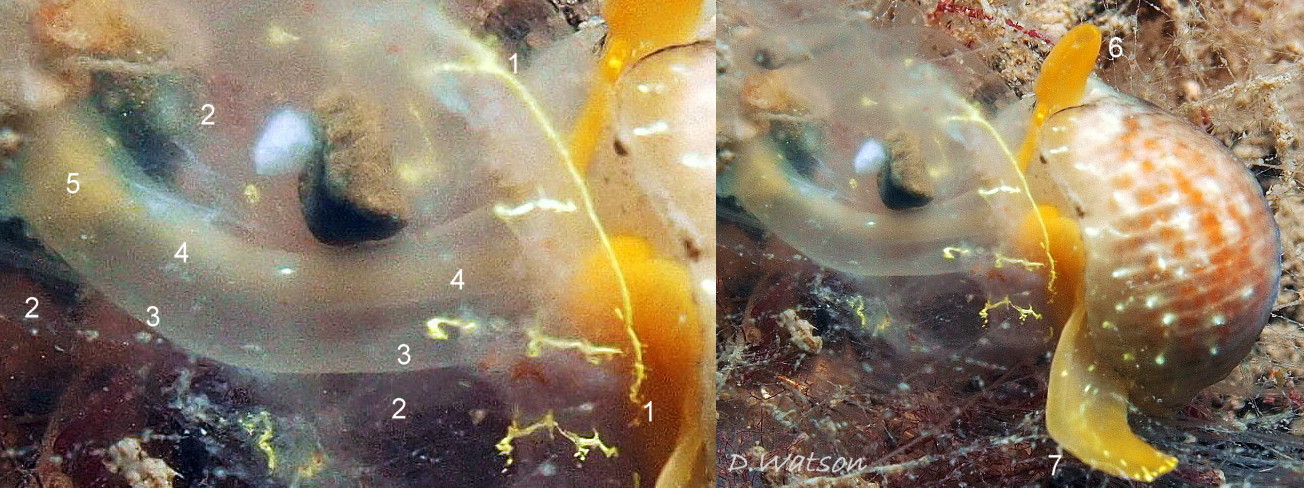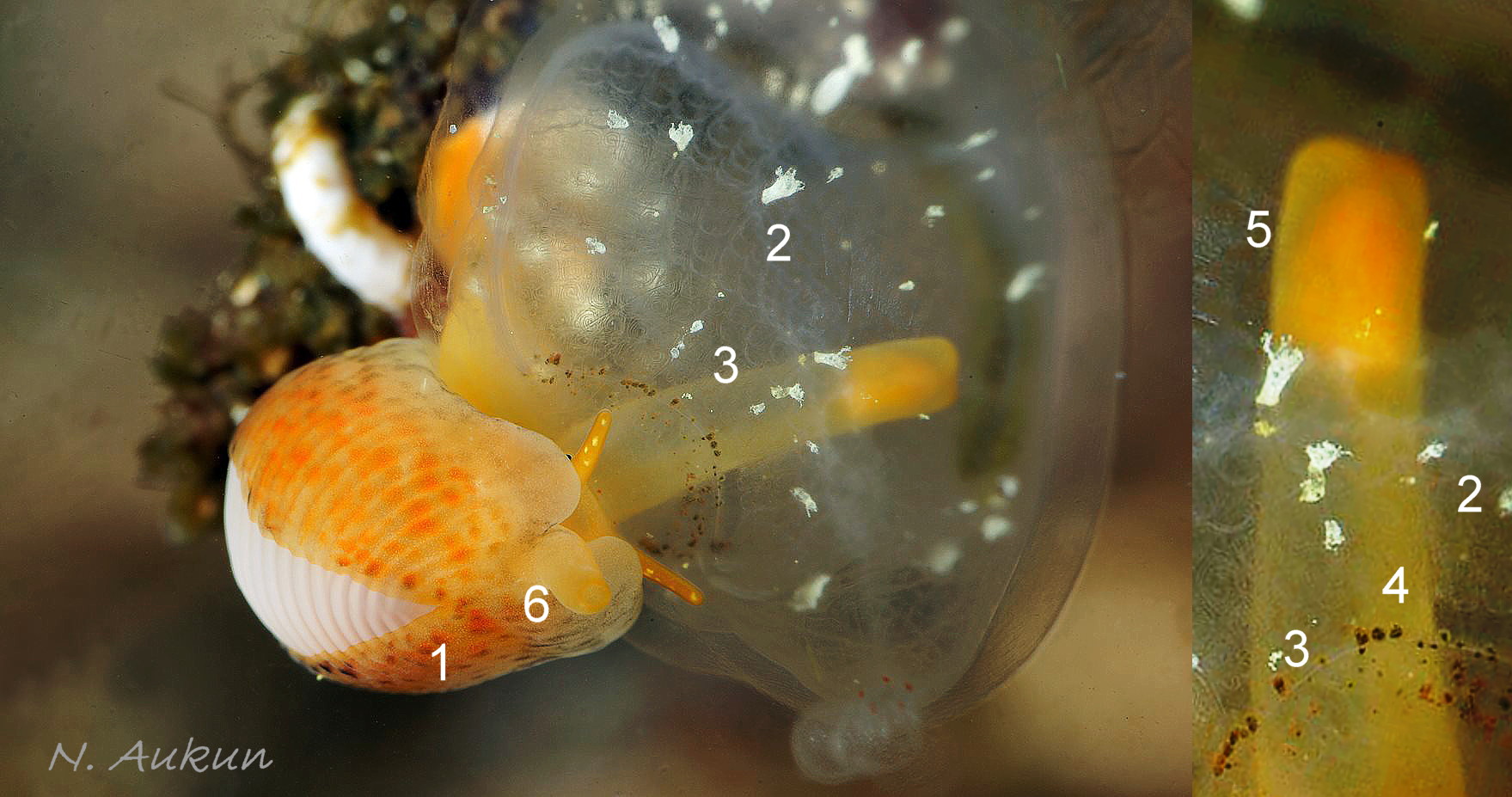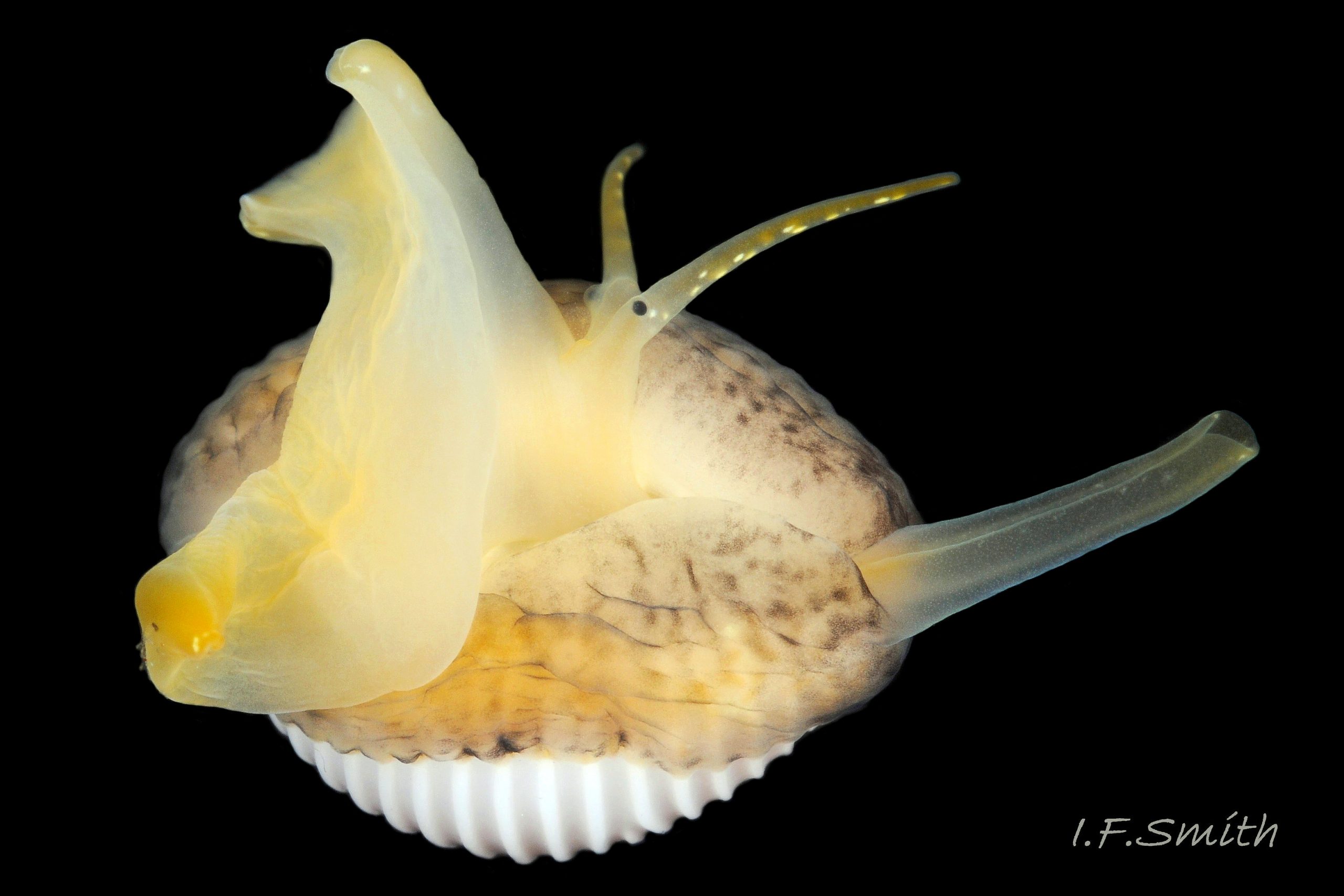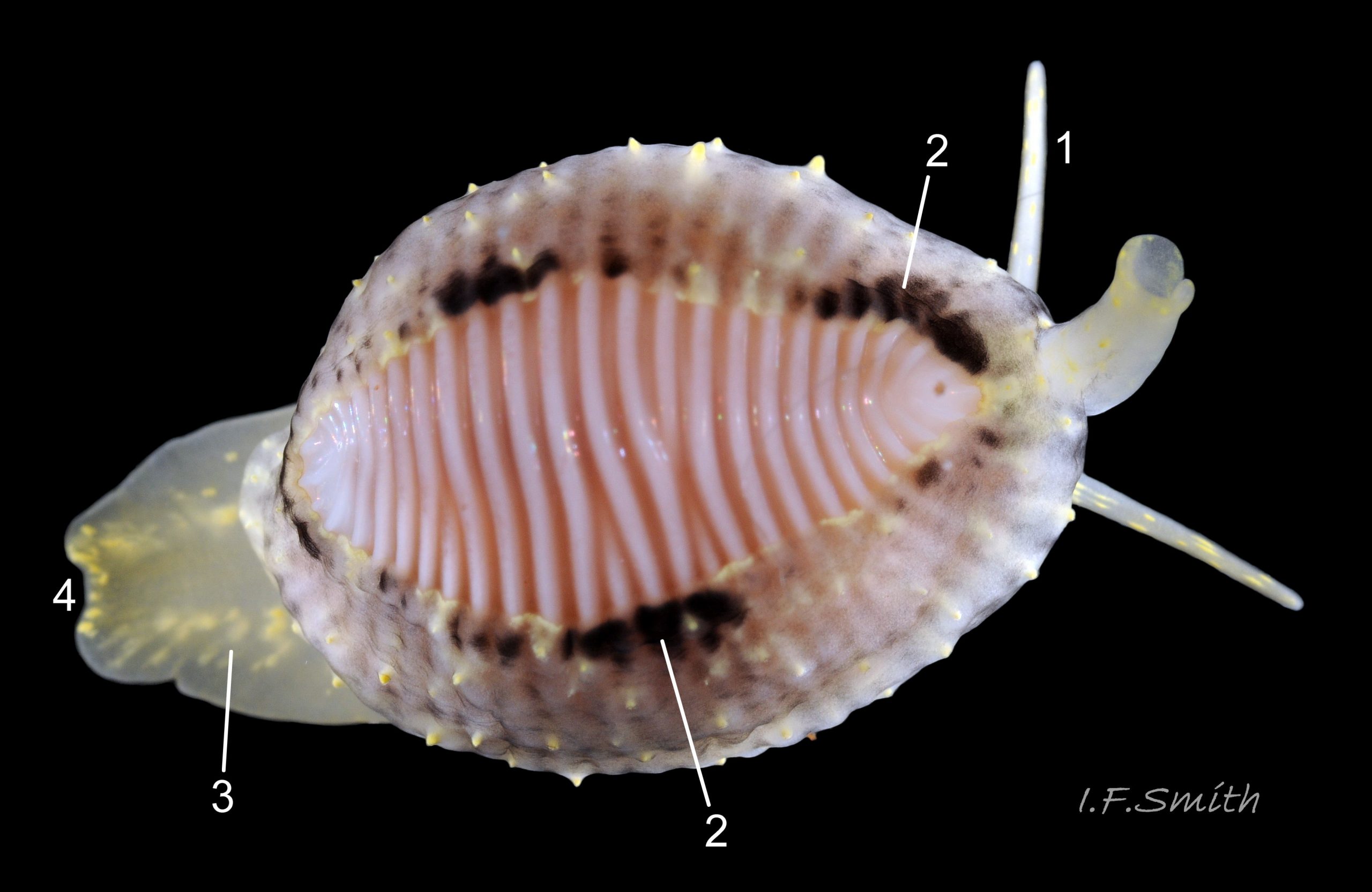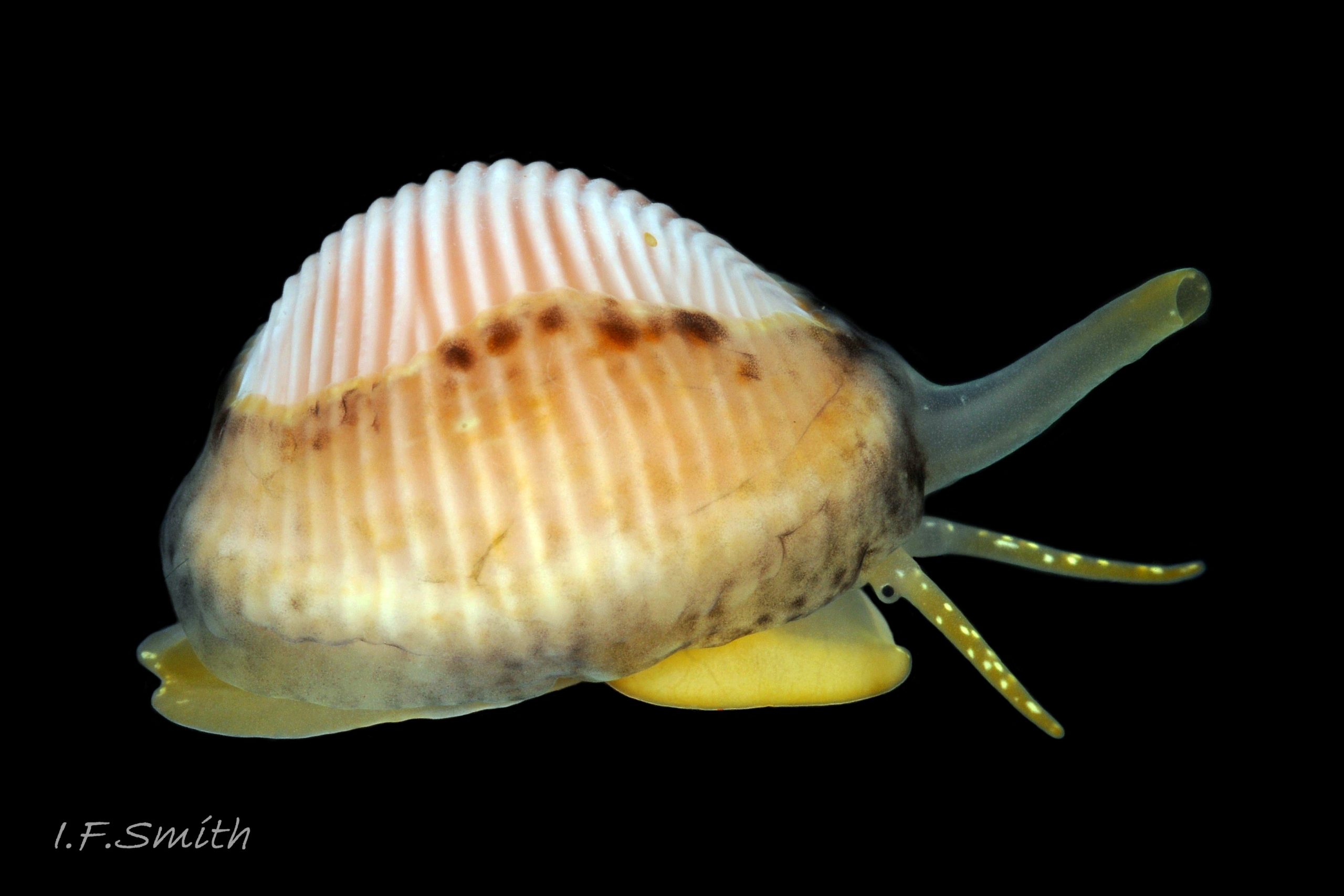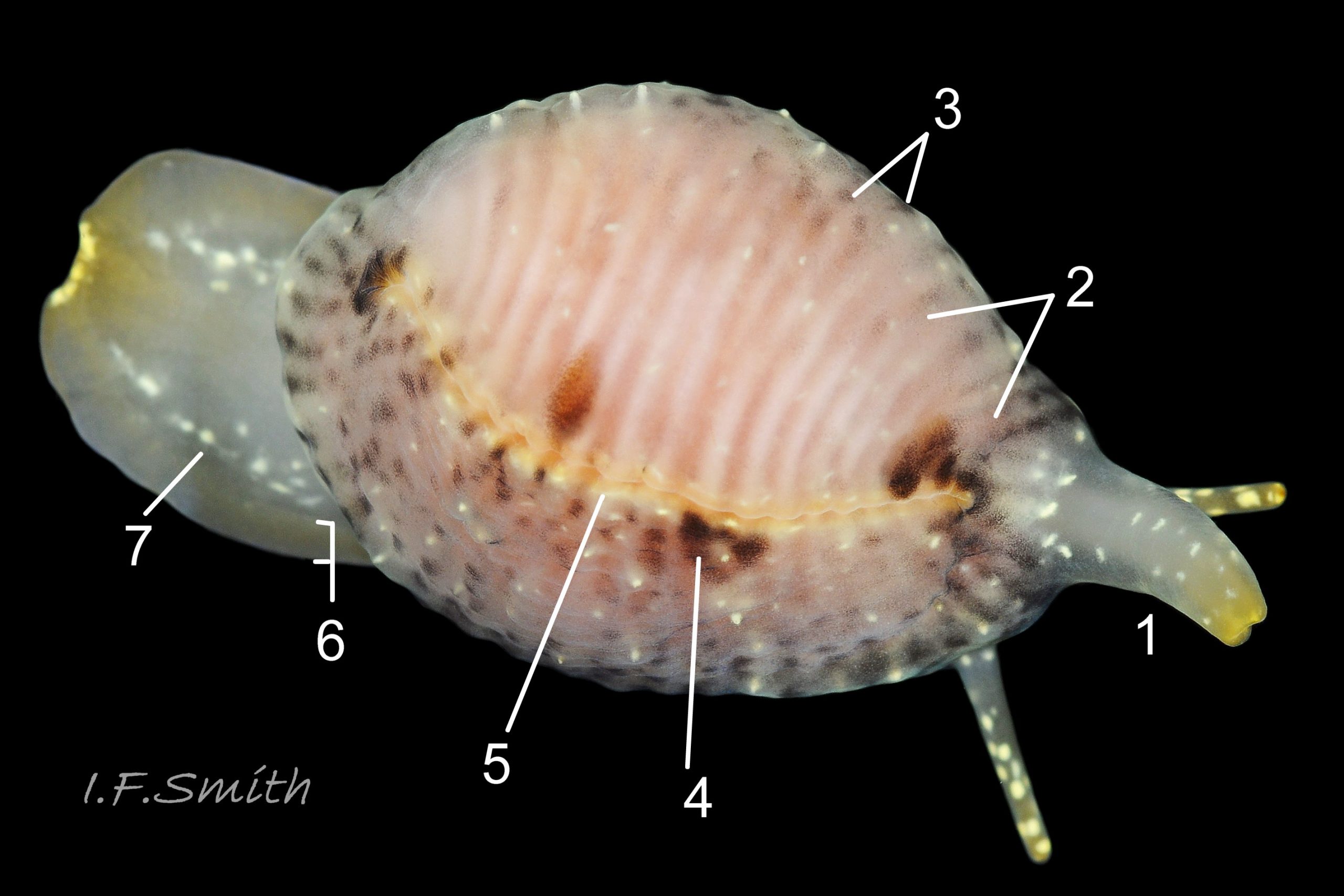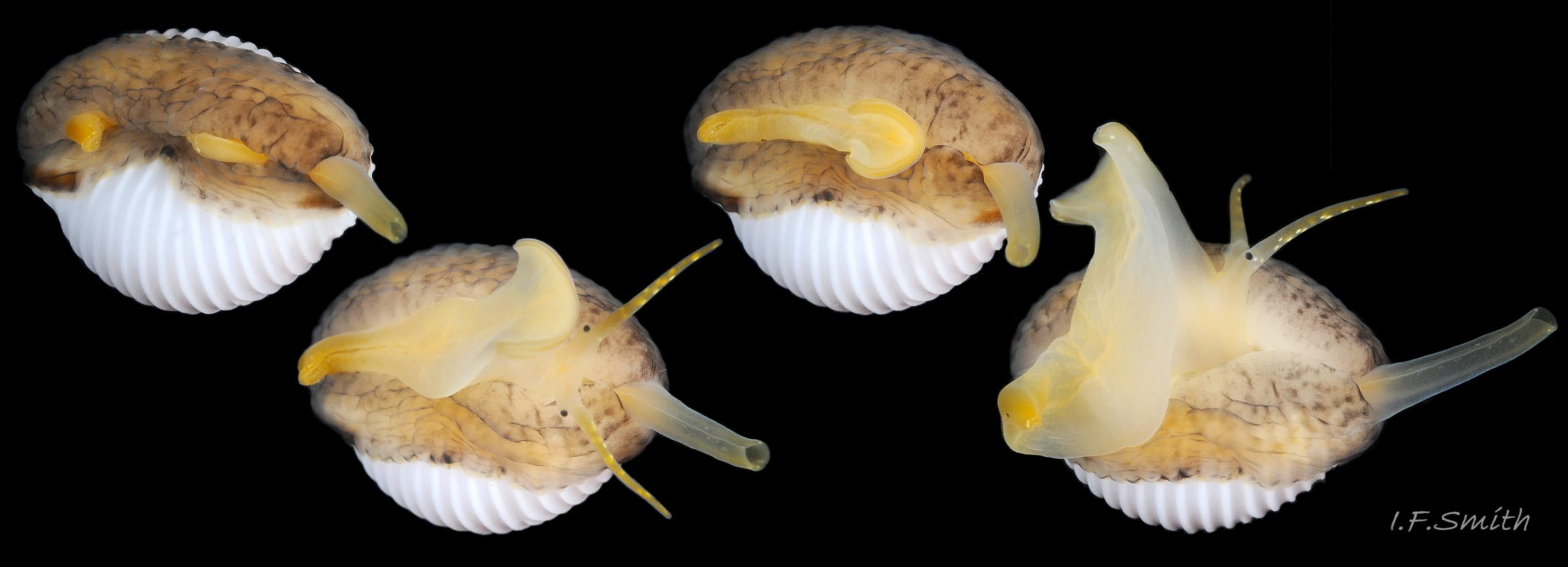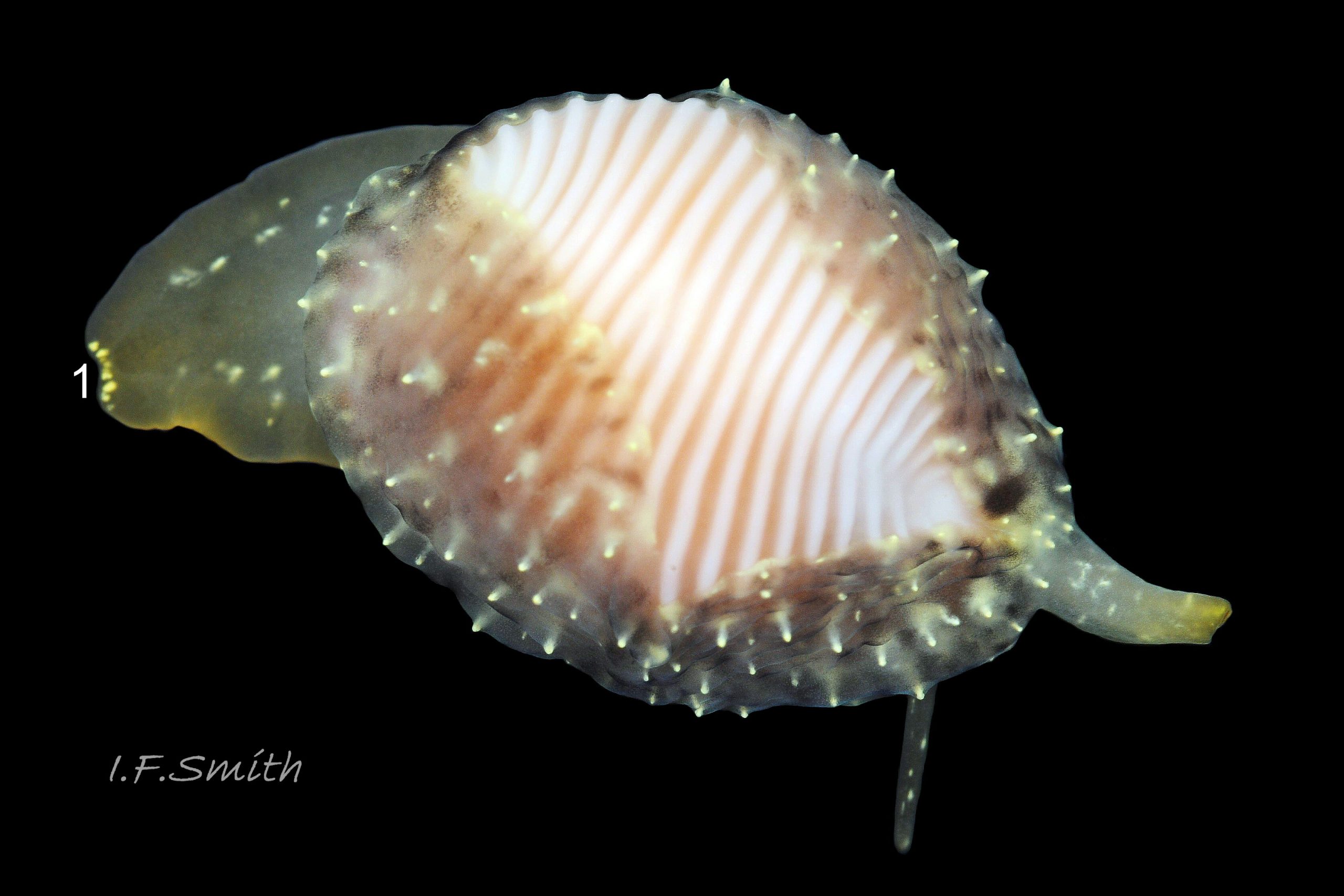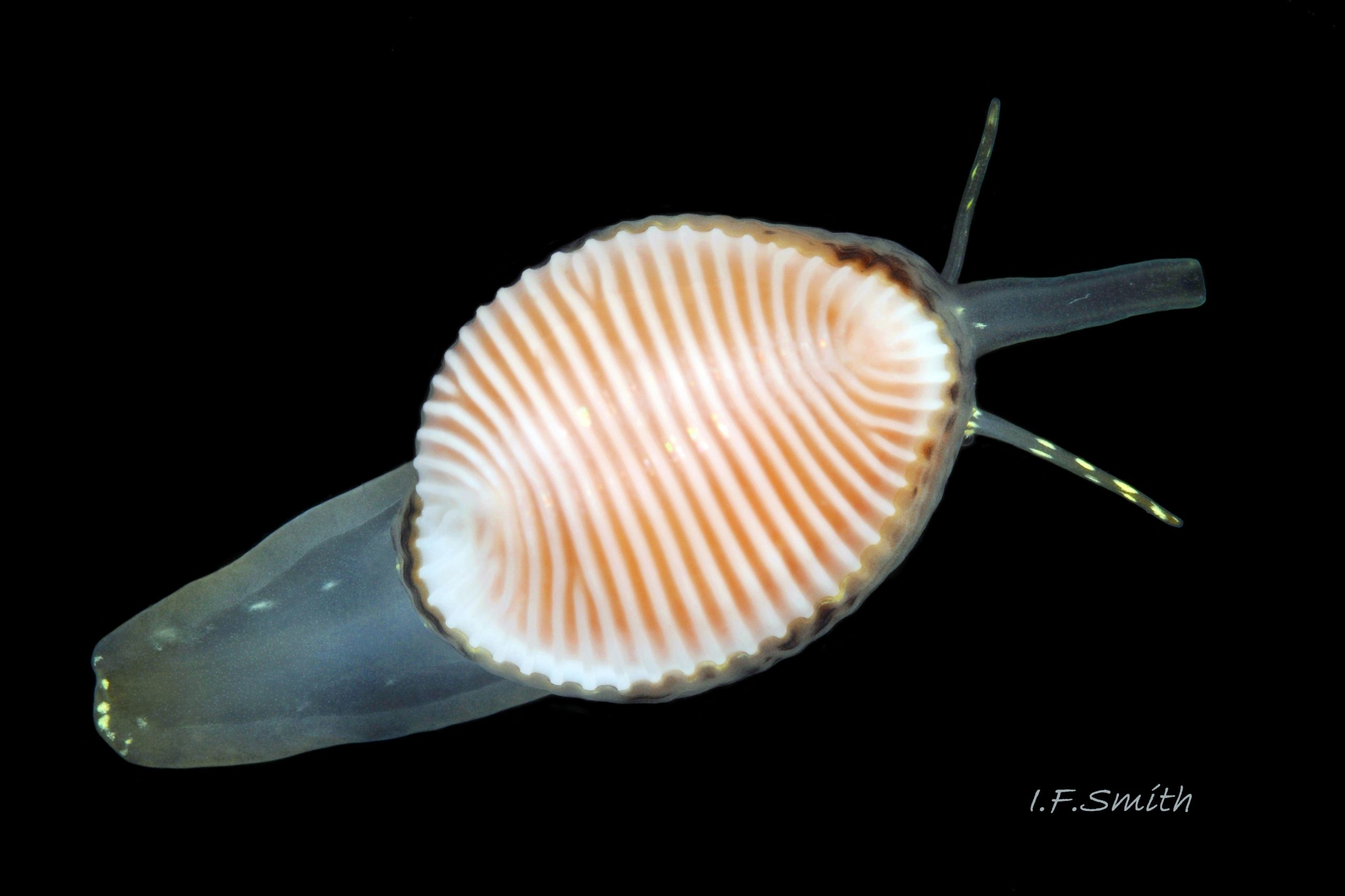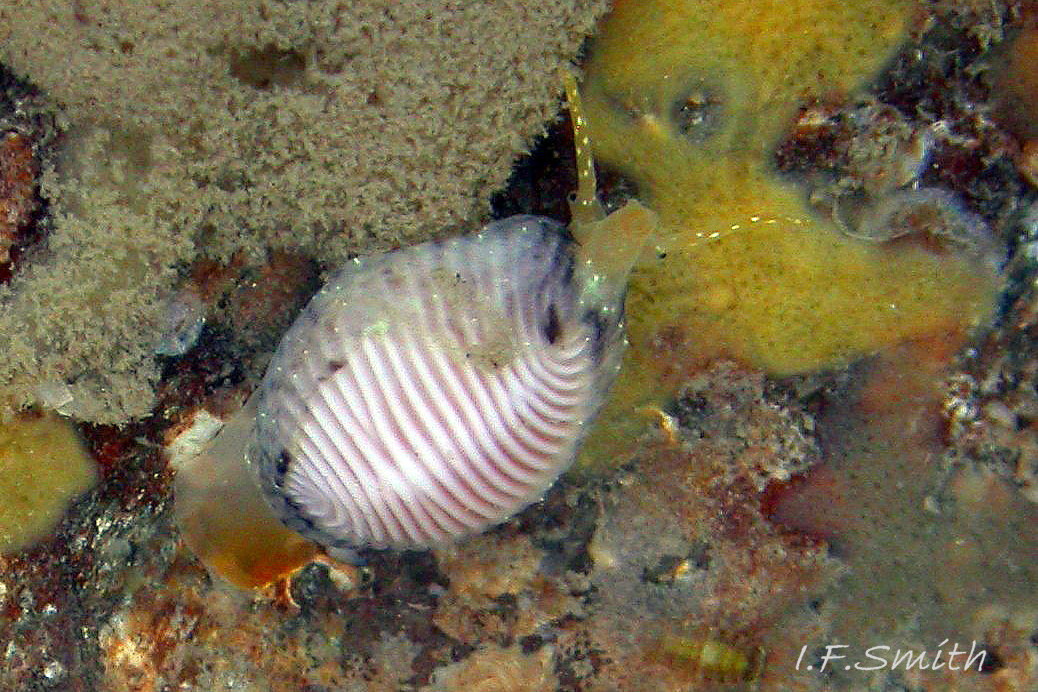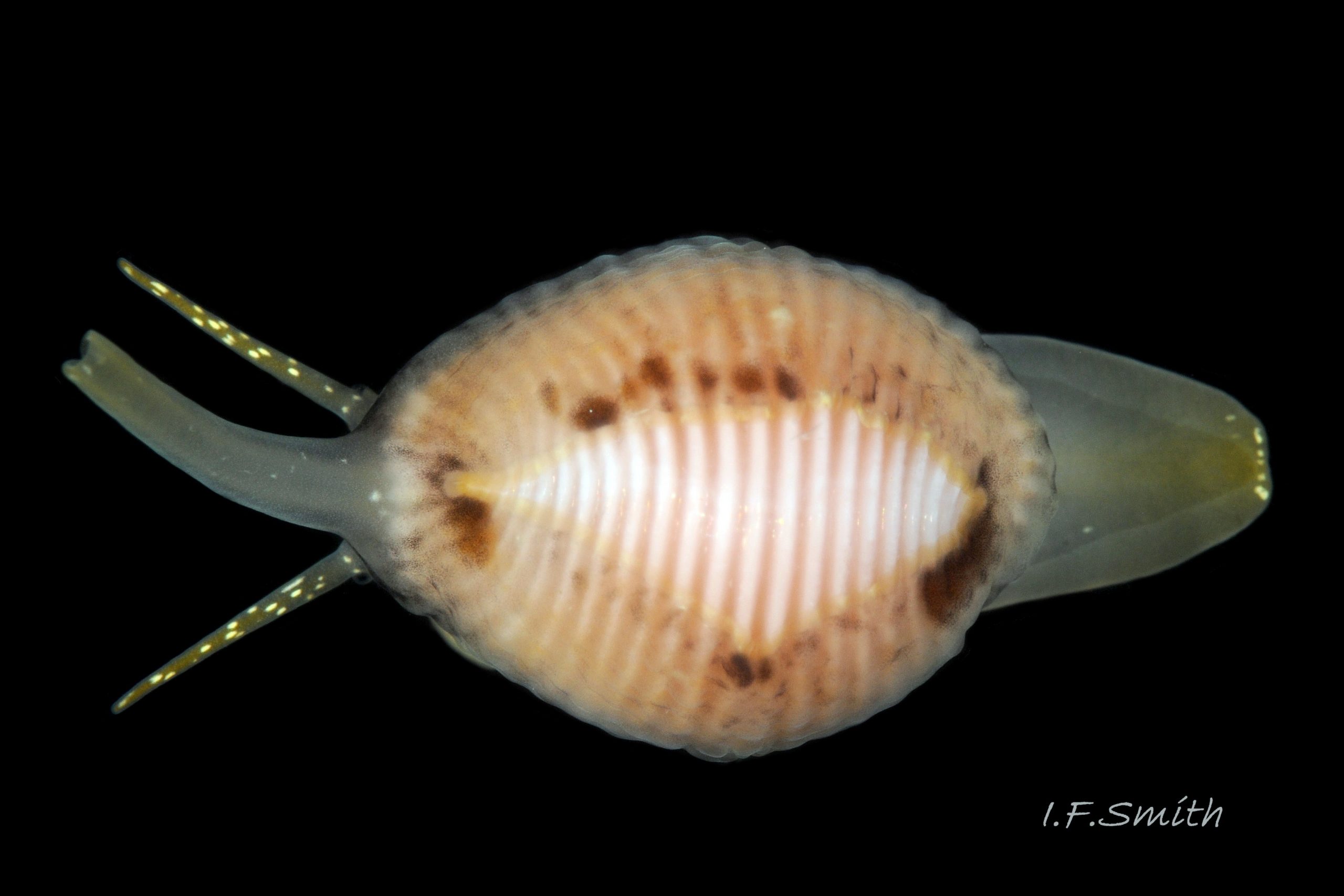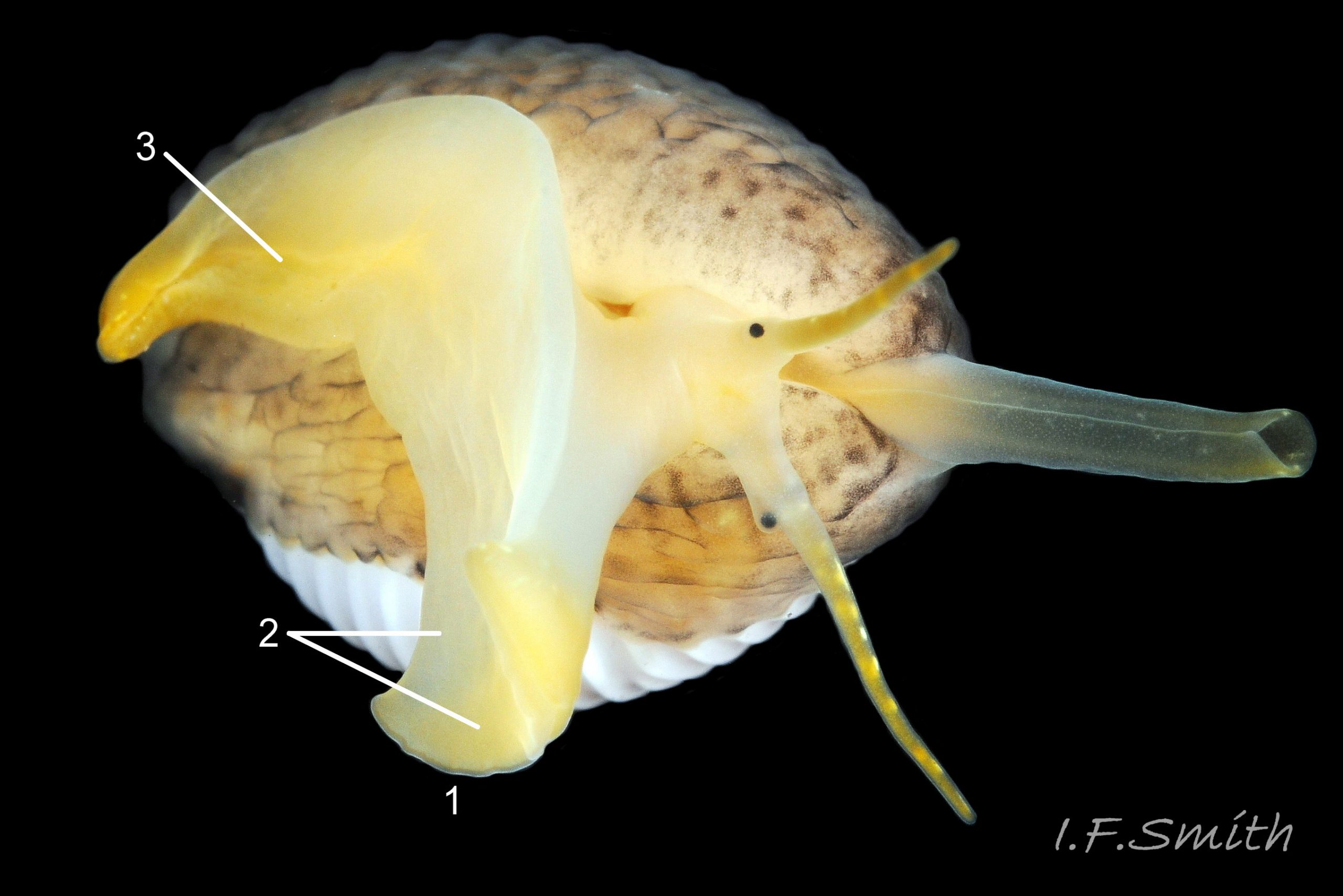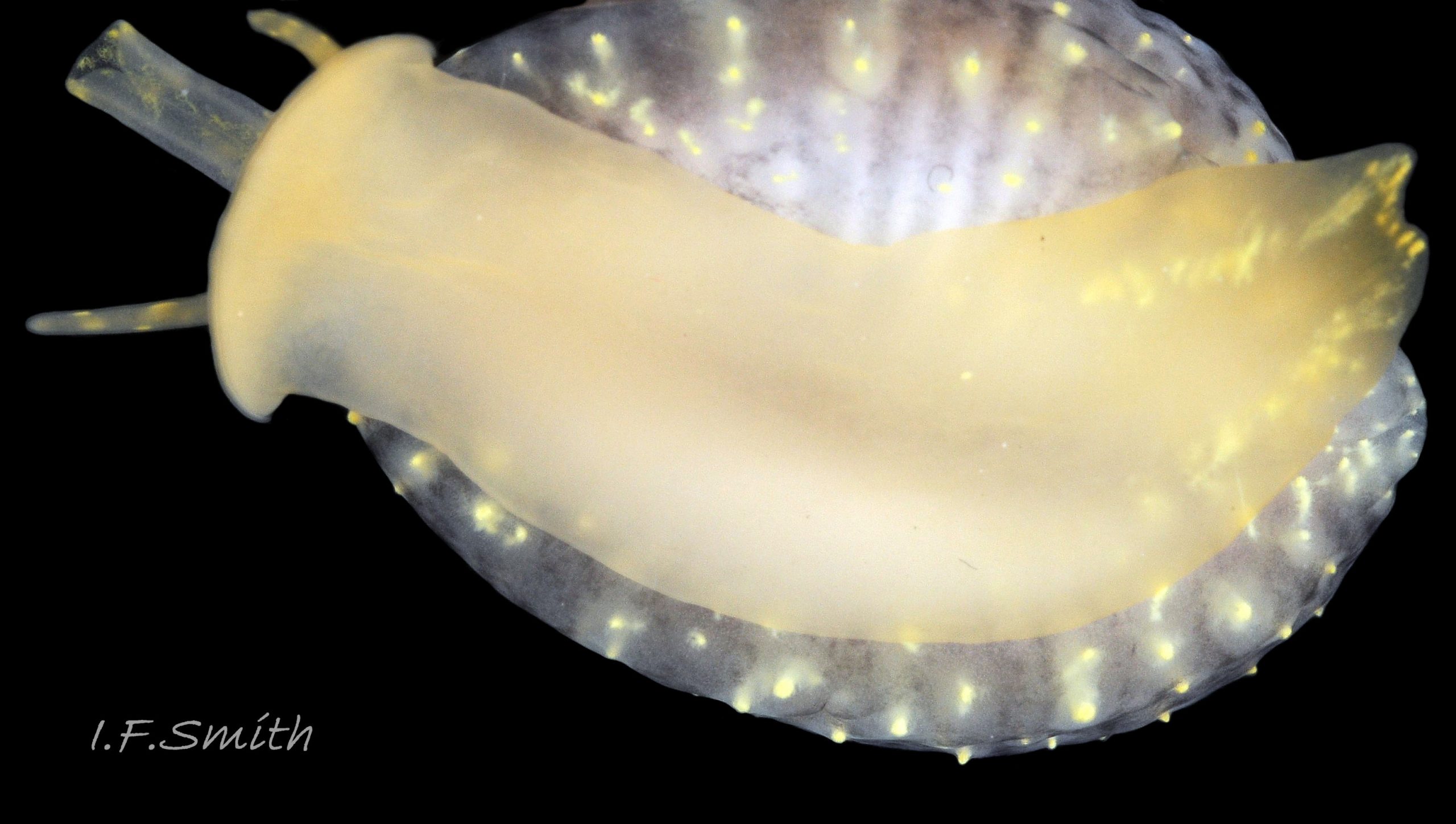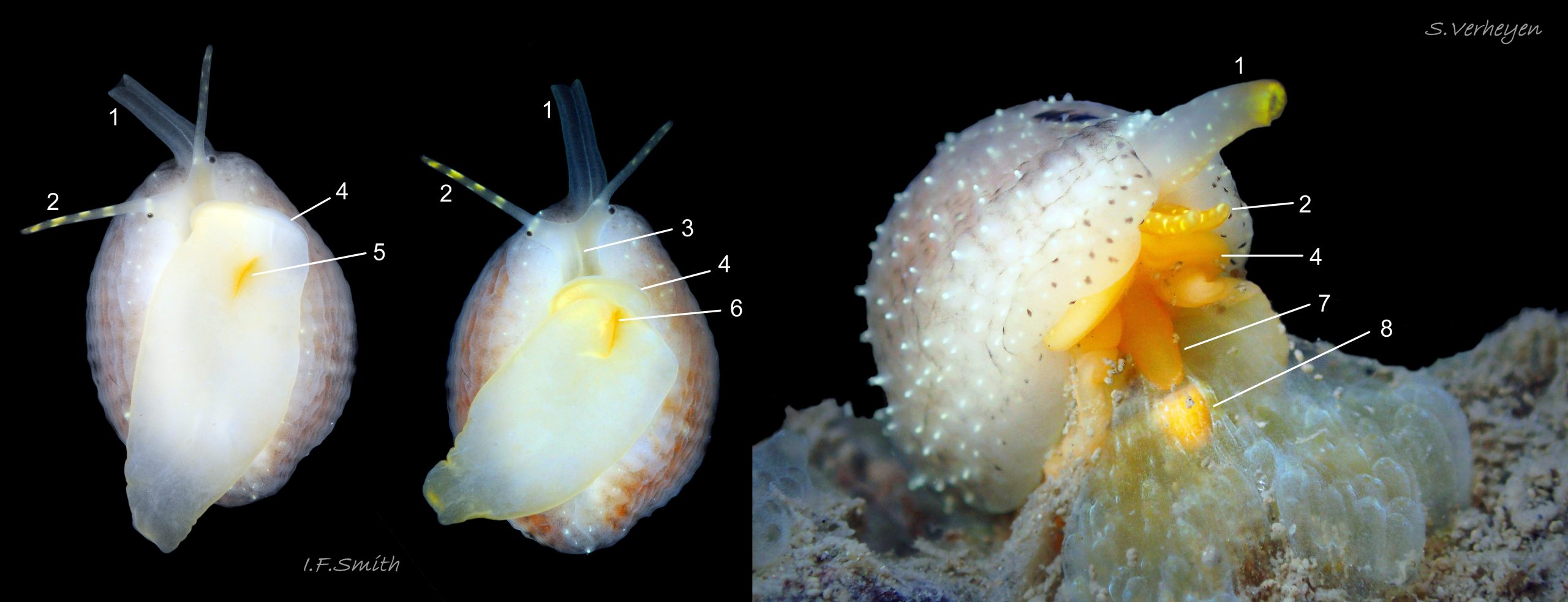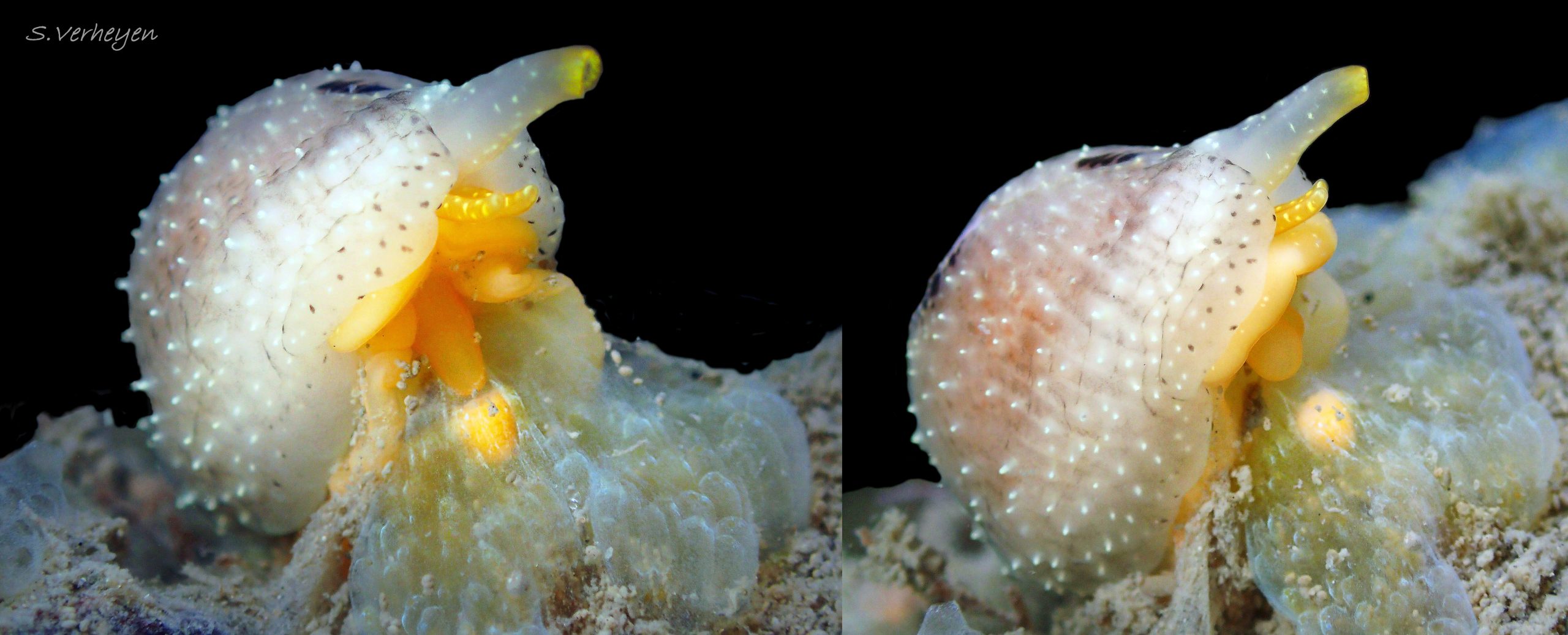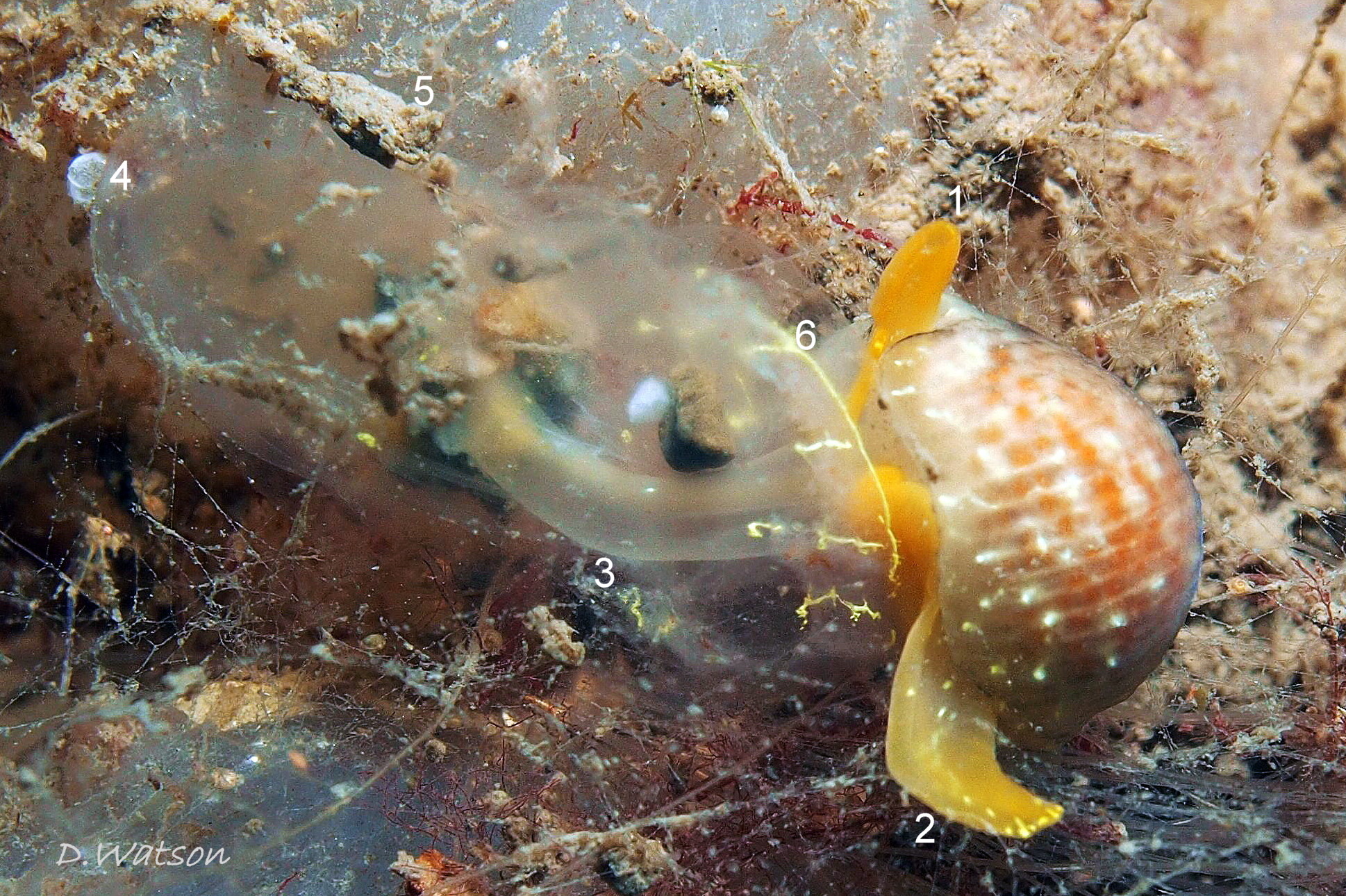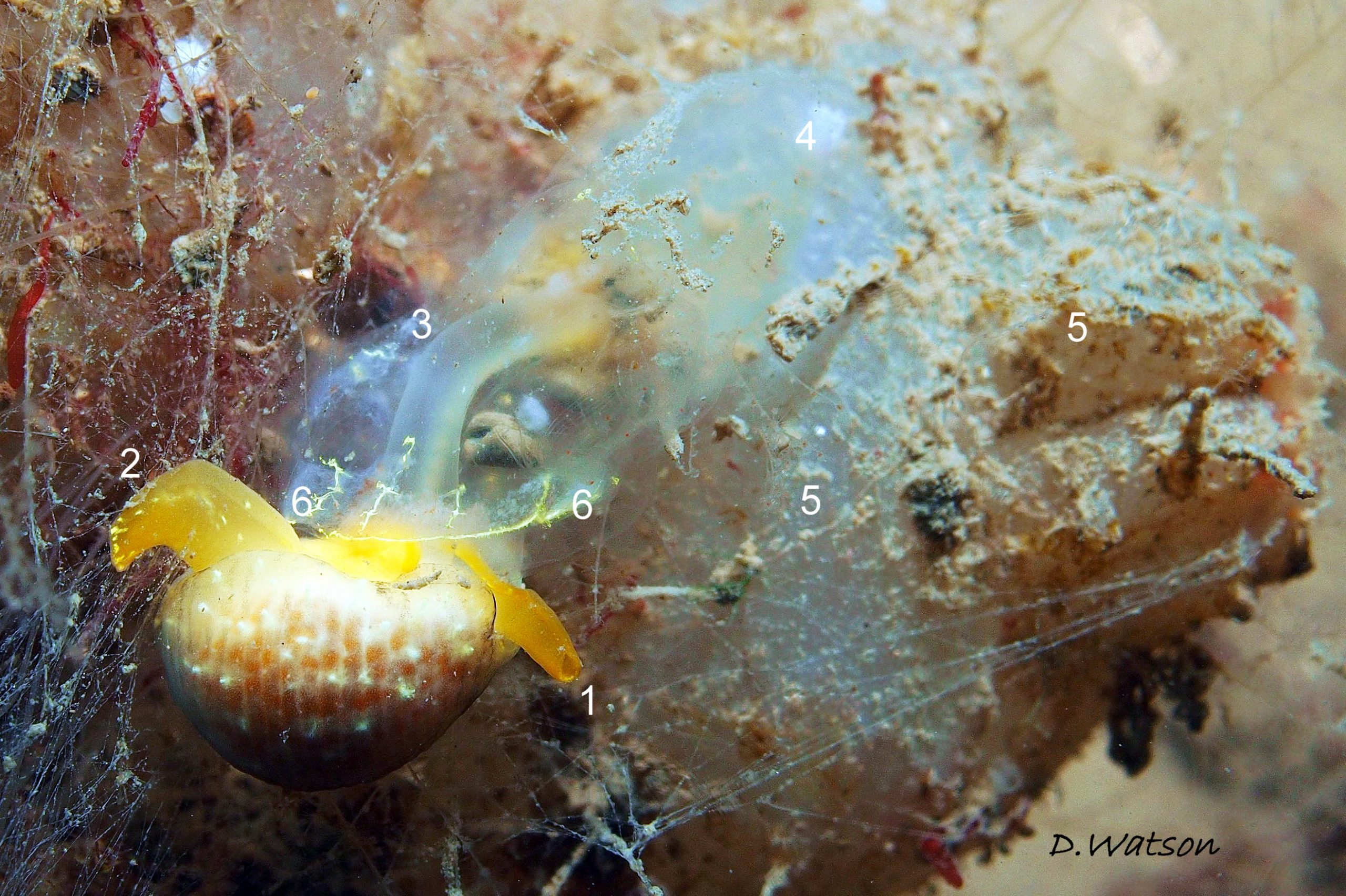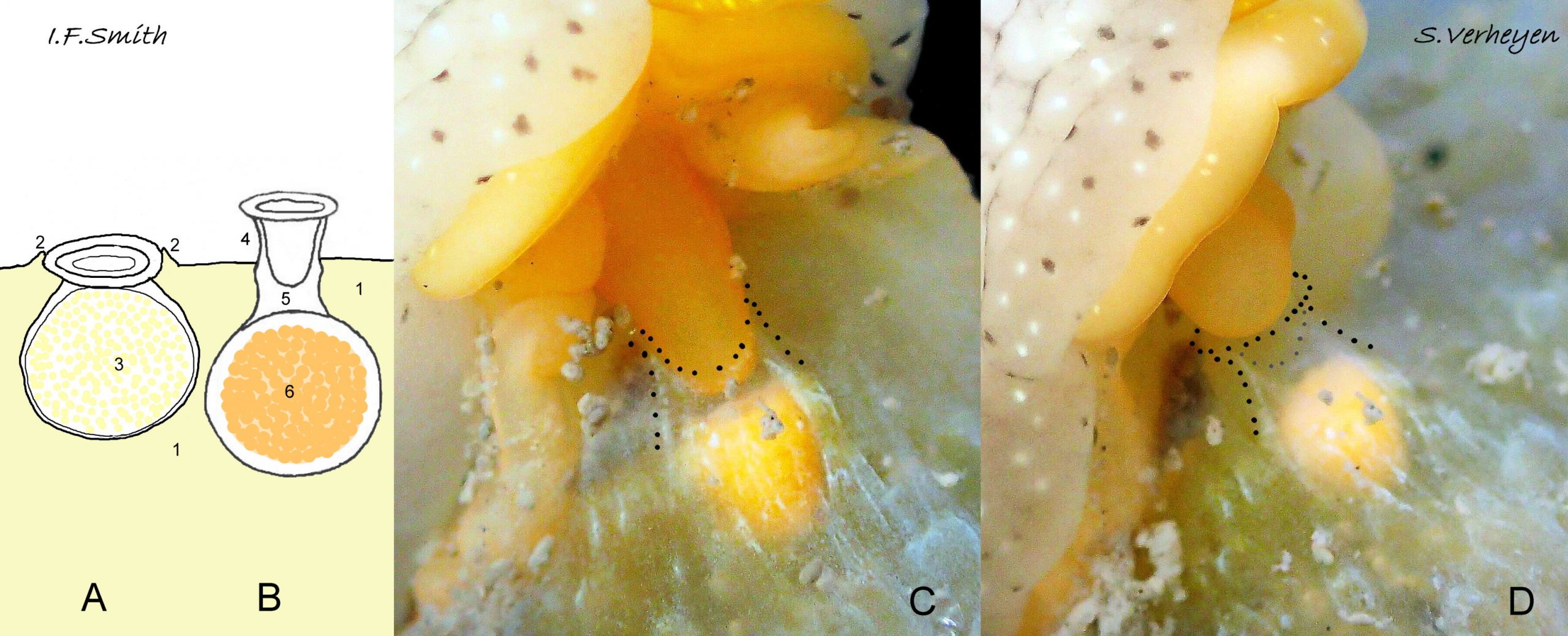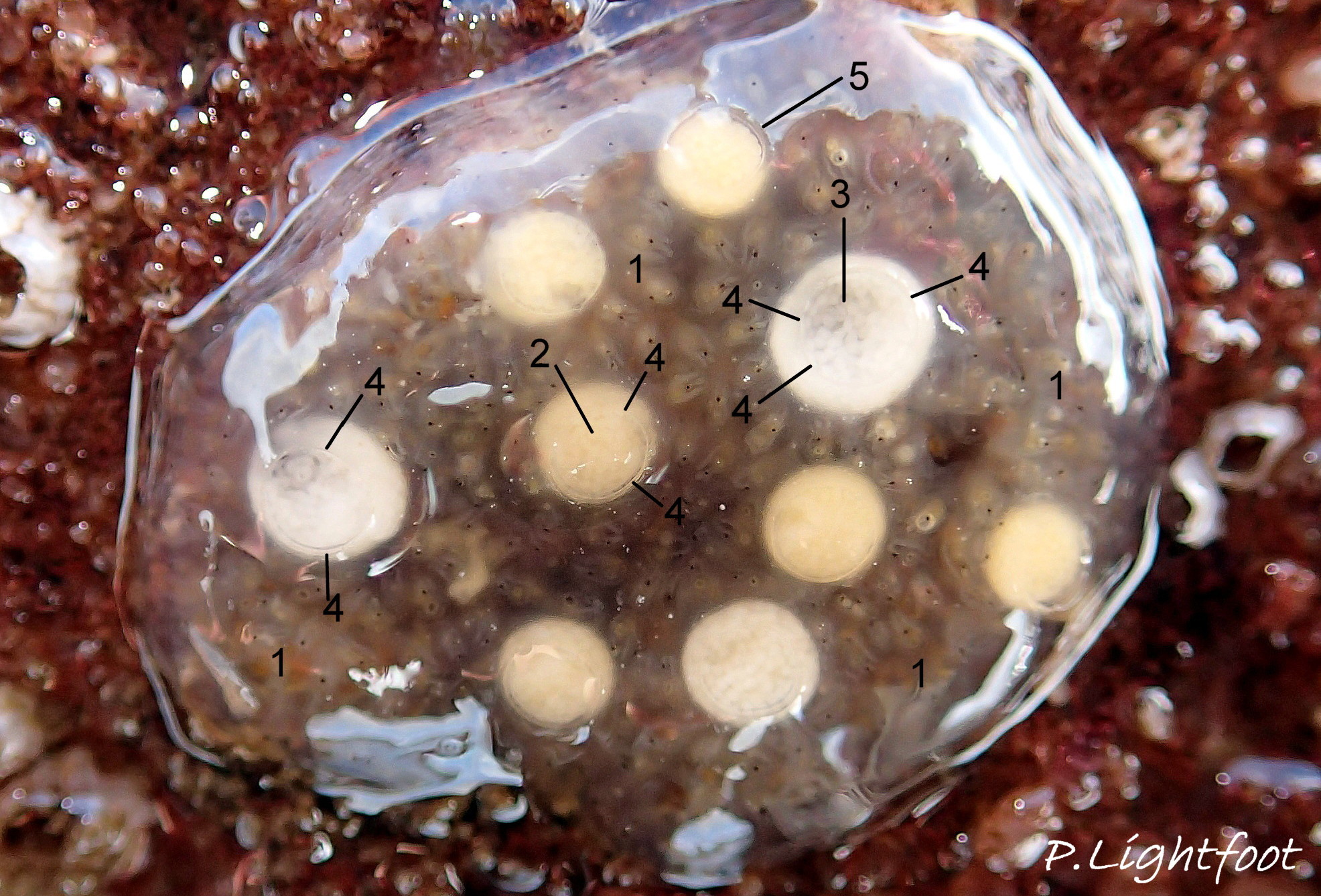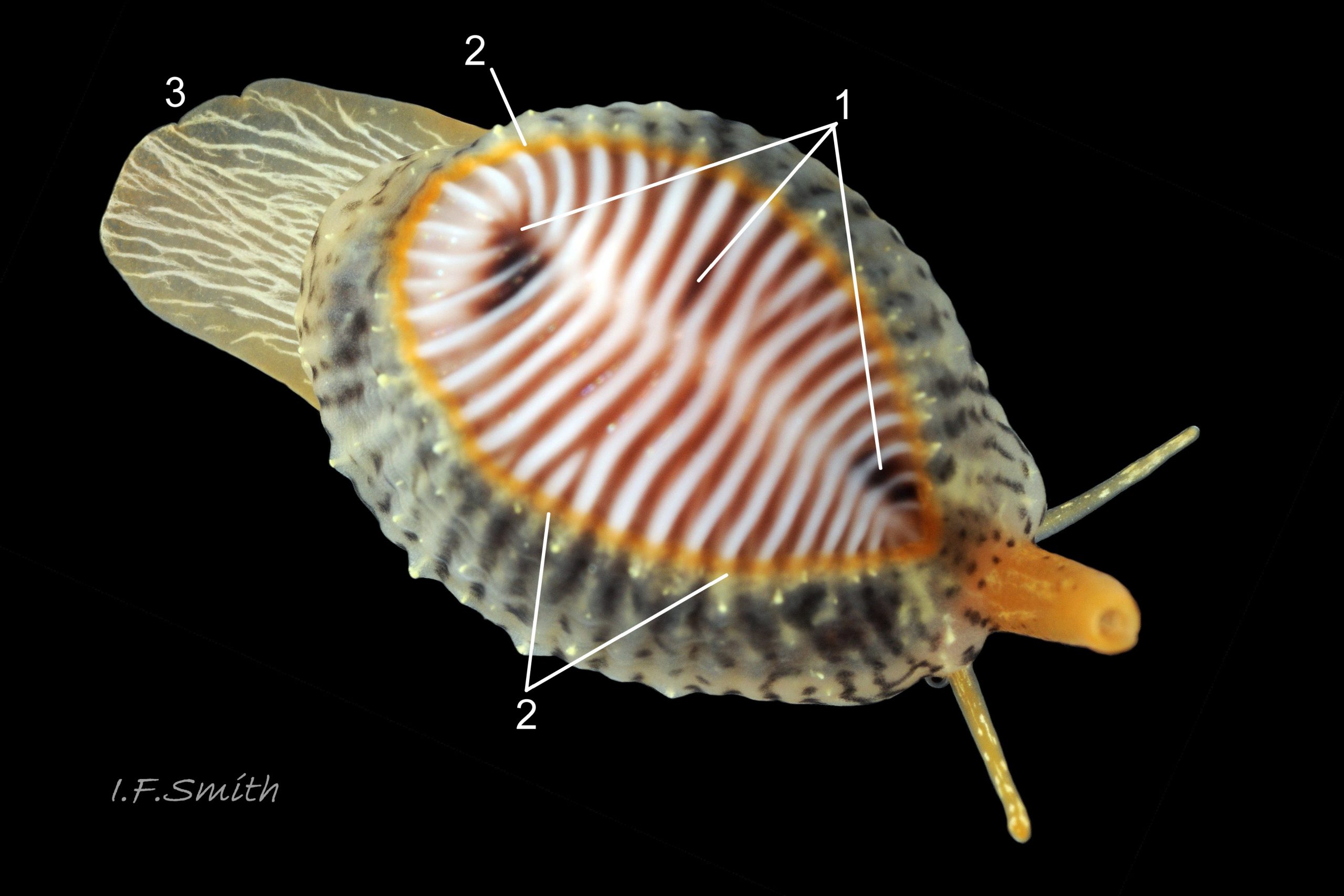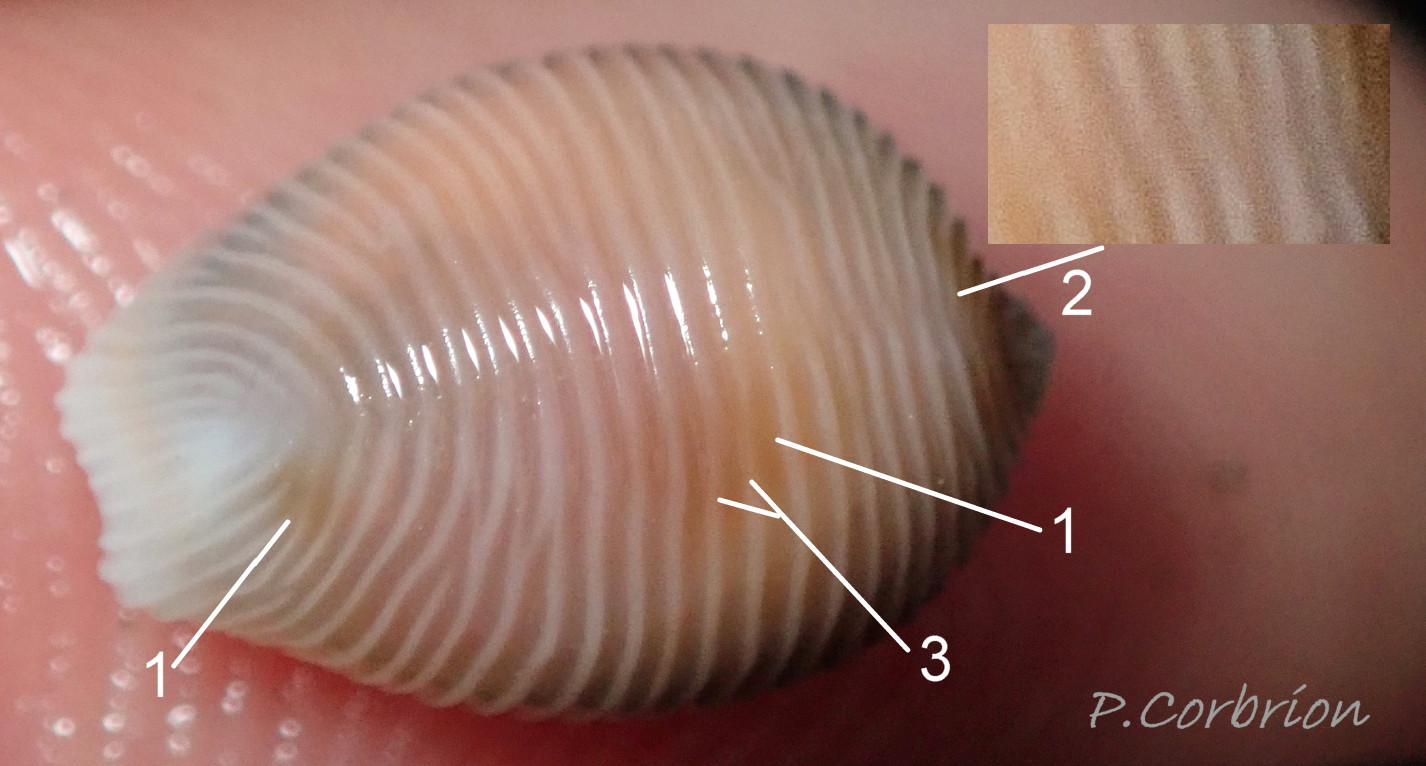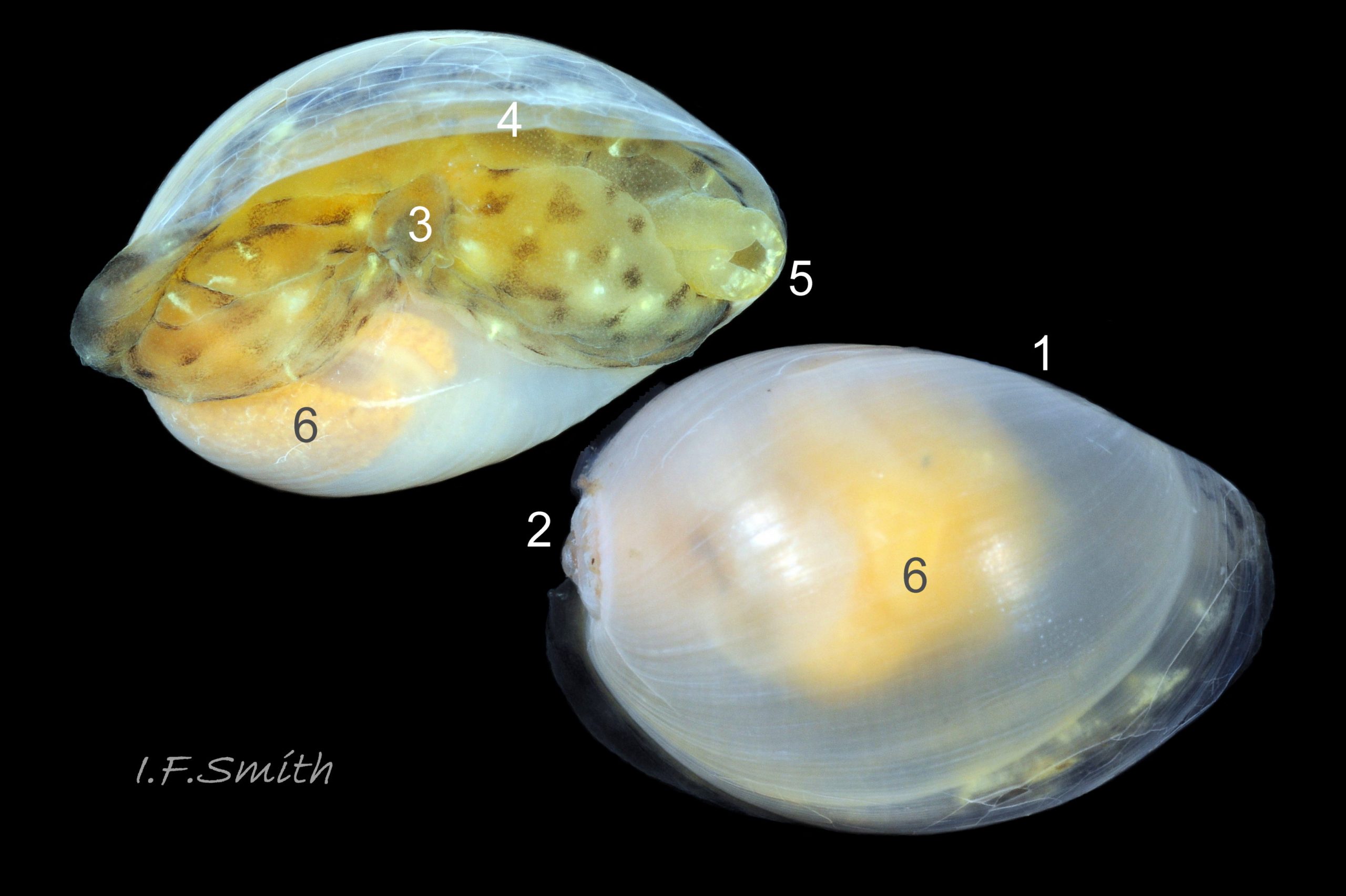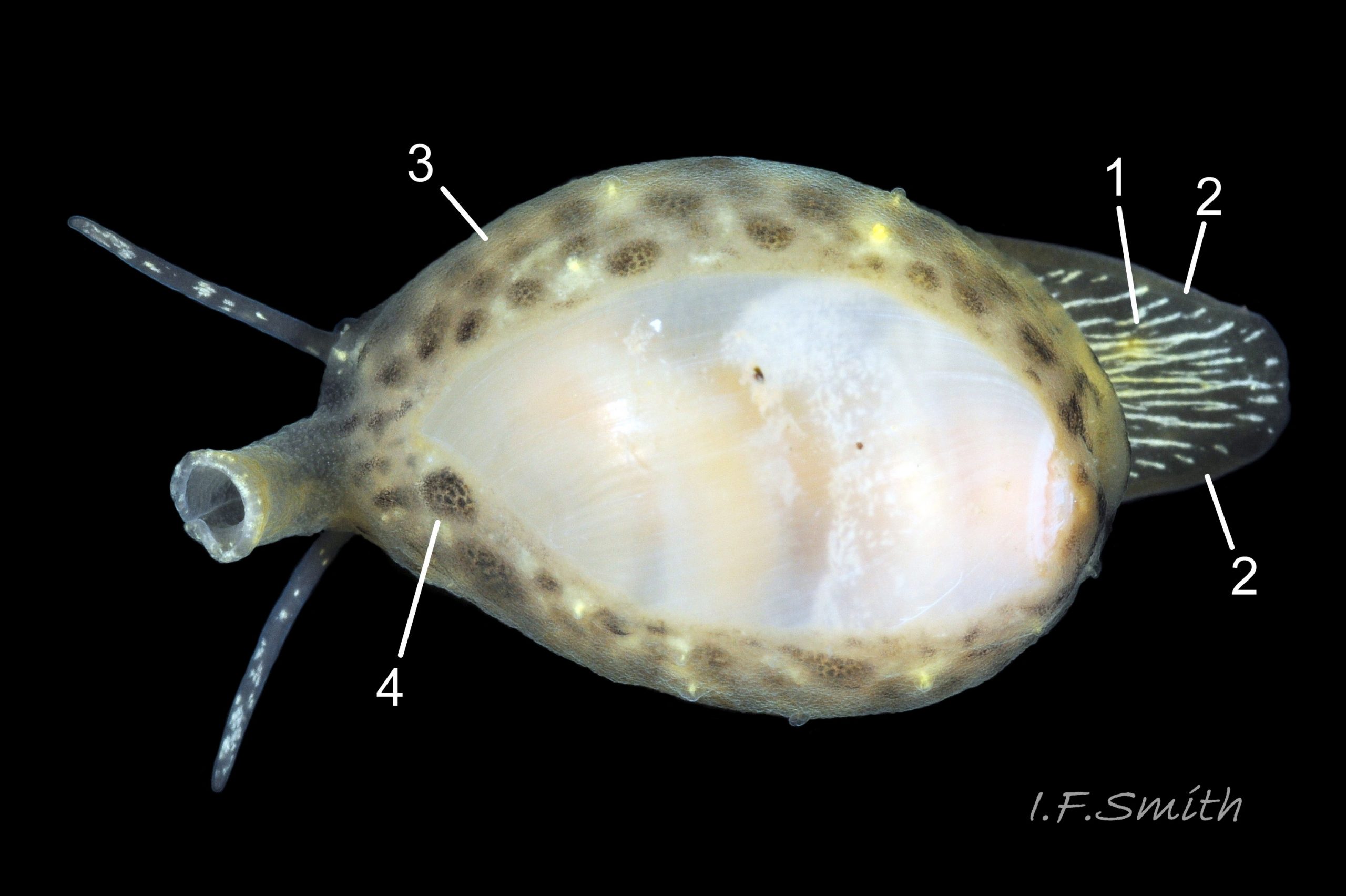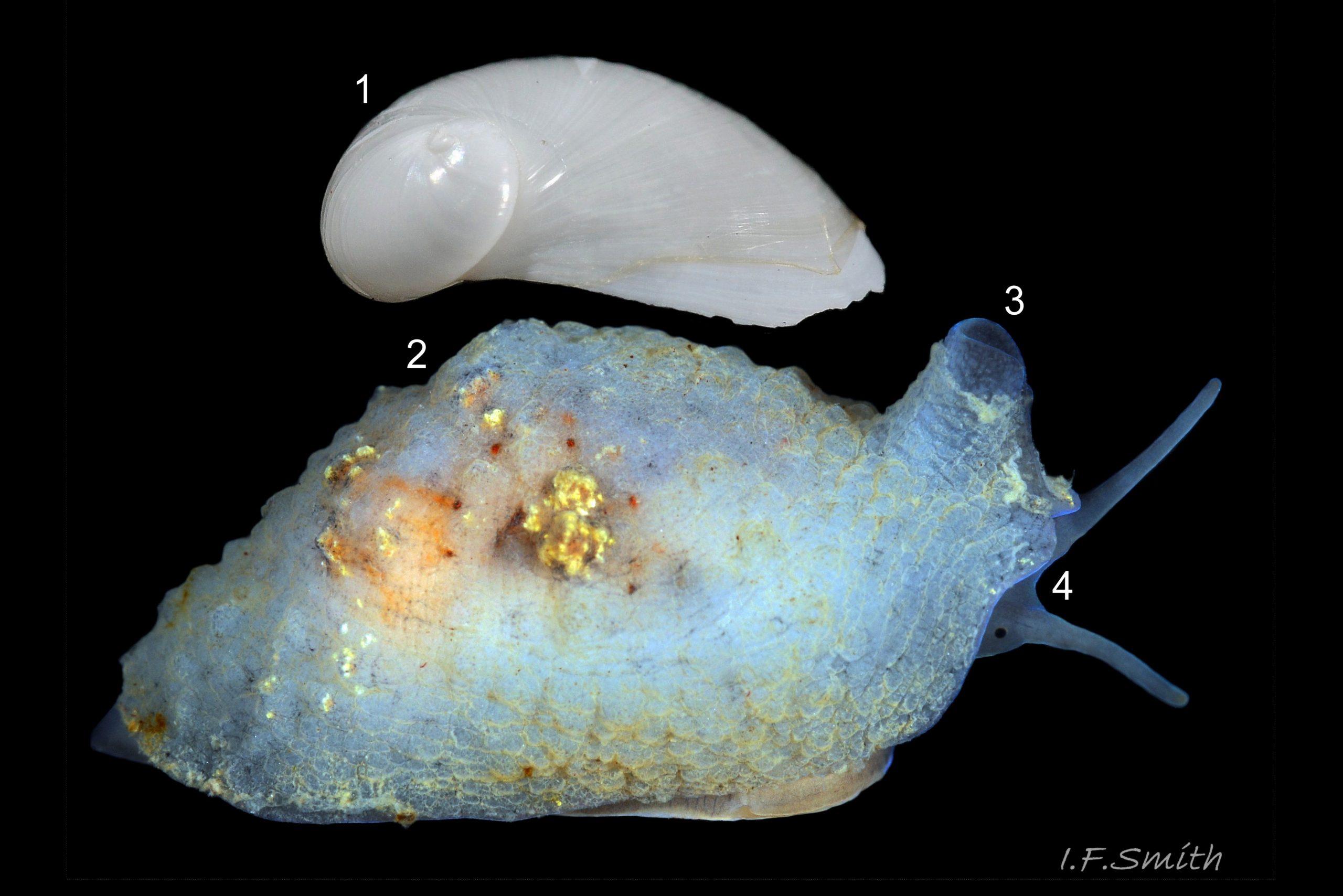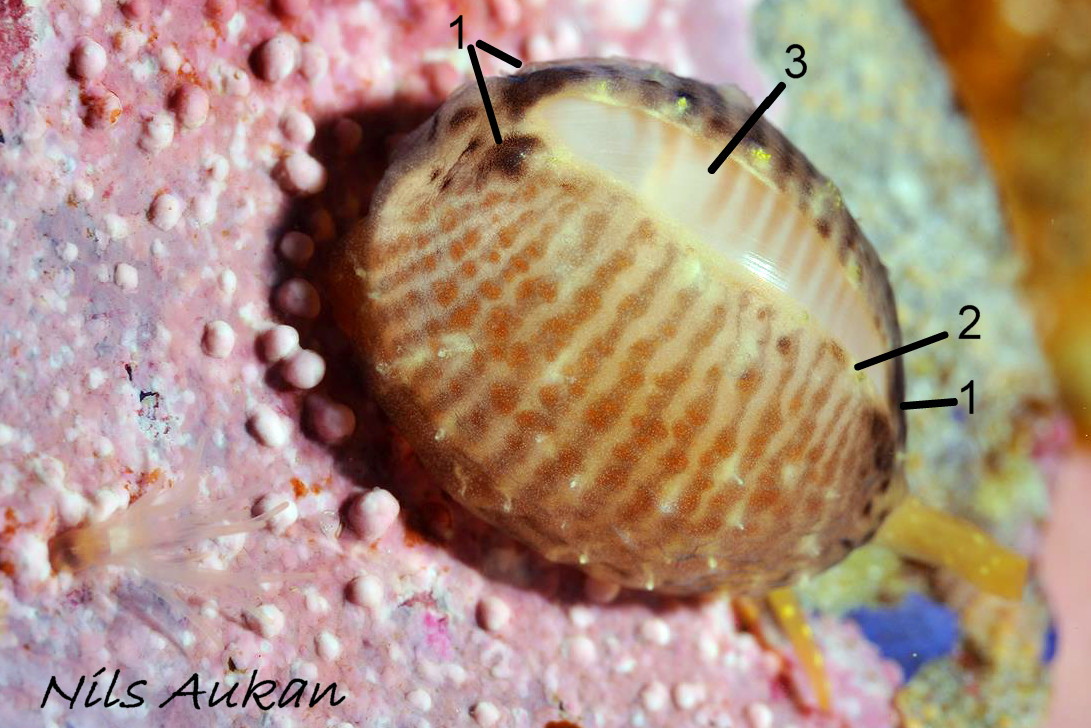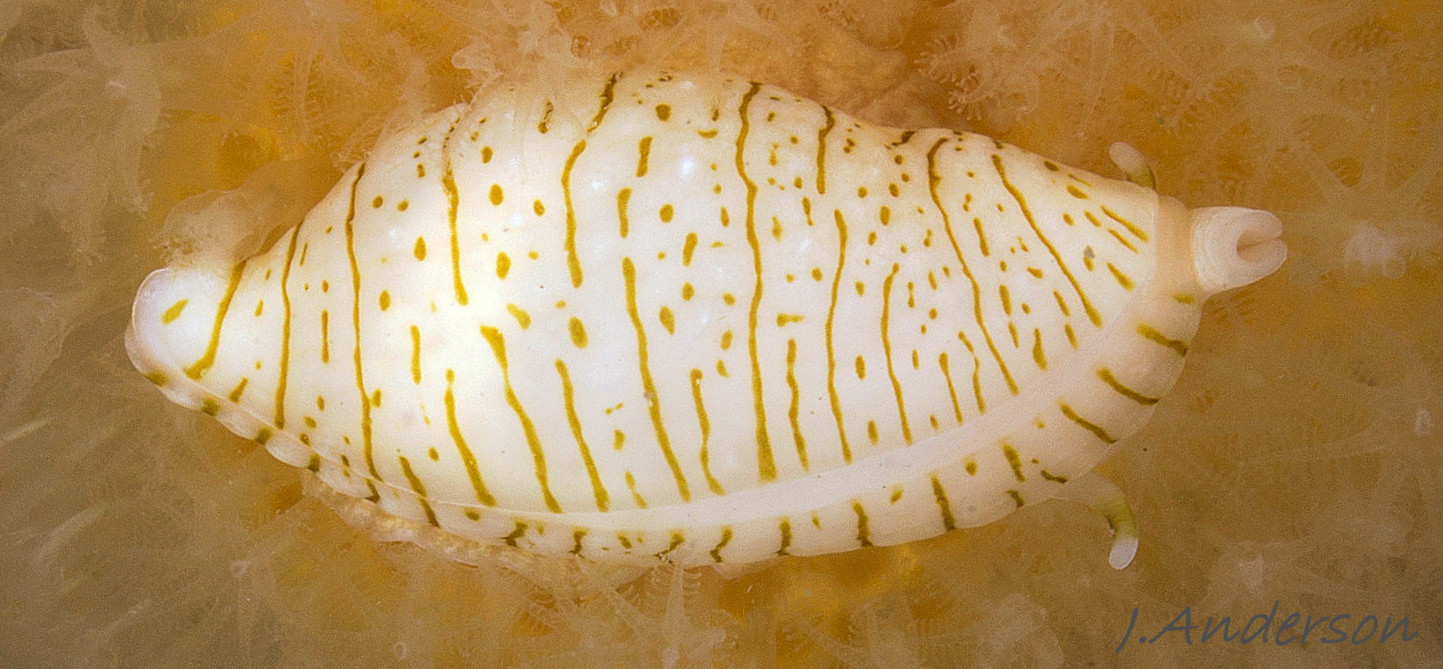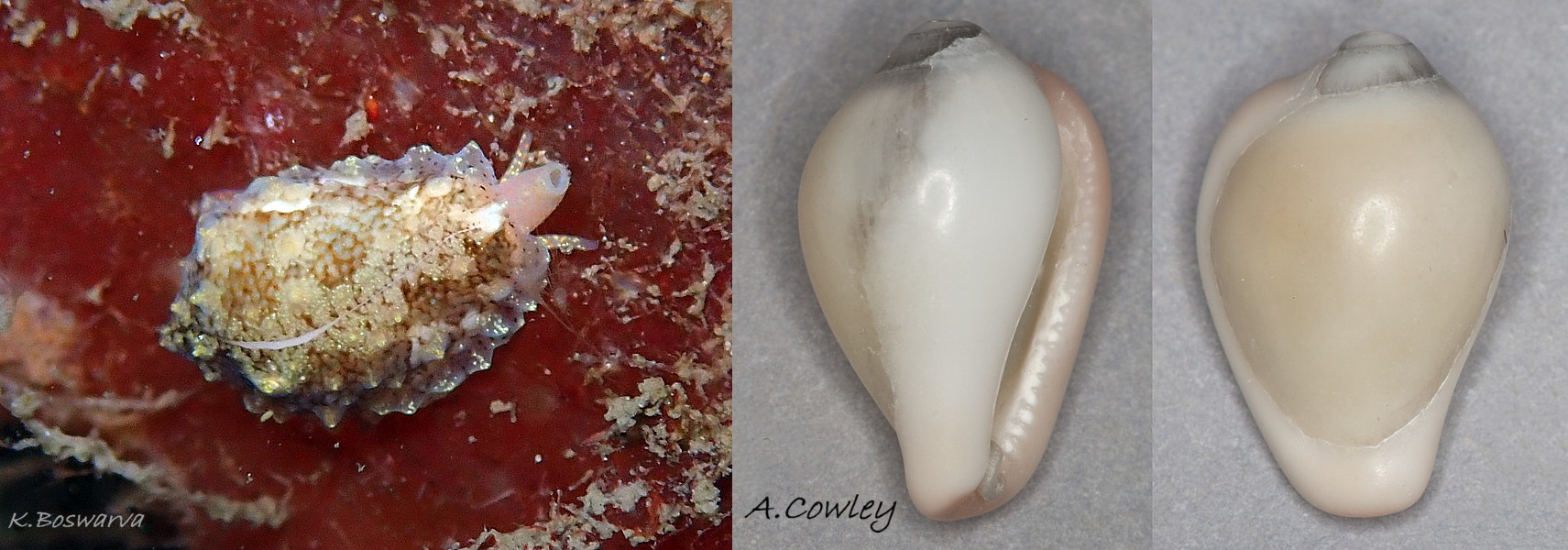Click image to enlarge with full caption. Main text below slider.
Trivia arctica (Pulteney, 1799)
Synonyms: Cypraea arctica Pulteney, 1779; Cypraea europaea Montagu, 1808 [= aggregate of T. monacha and T. arctica in Forbes & Hanley, Jeffreys, and many authors pre-1925]; Cypraea europaea var. minor Marshall, 1893; Trivia mollerati Locard, 1894.
Current taxonomy: World Register of Marine Species (WoRMS) http://www.marinespecies.org/aphia.php?p=taxdetails&id=141744
Meaning of name: (Latin)Trivia = a common thing; arctica = northern
Vernacular: Northern cowrie, Unspotted cowrie (English); Cragen fair y gogledd (Welsh); Ongevlekt koffieboontje (Dutch); Nordlig kauri (Danish). Sometimes “Arctic cowrie” is used, but a misnomer as not a typical Arctic species, just a few records beyond Arctic Circle in Norway where Atlantic Drift brings anomalous temperate water far north.
Names applied to both T. monacha and T. arctica: European cowrie, nun, sea-cradle, maiden, stick-farthing, (English); Groatie-buckie (Scots); Cragen fair (Welsh); Europäische Kauri (German); Pucelage; Pou-de-mer; Porcelaine puce; Grain de café (French); Kaffebønne (Norwegian); Freirinha (Portuguese); Porcelanita (Spanish).
GLOSSARY below.
Adult shell description
In Britain, adult T. arctica are usually from 8 mm to 12 mm high (longest dimension of shell) 01 Trivia arctica. They are broadest towards the apical end. In the Mediterranean they are usually smaller; Vayssière (1923) in Lebour (1933) gives height extremes of 6-12 mm at Marseilles. The shell is ovoid with a flatter apertural/ventral face 02 Trivia arctica, likened in its vernacular names to a coffee bean (Dutch, French, Norwegian) or kernel of oats (Scots). The shell is convolute with all earlier whorls hidden from view by the enveloping final whorl; a slight pimple or mound on posterior end sometimes indicates the position of the hidden apex 01 Trivia arctica. It is solidly built with an adult sculpture of 20-25 ribs crossing the entire shell with a few short intervening ribs. The intervening grooves are the same width as the ribs. The ribs of left and right sides are perfectly aligned where they meet with no discontinuity on the dorsum (van Nieulande et al., 2022 & 27.1 Trivia arctica. There is a thickened white labial varix on the left 02 Trivia arctica.
The aperture is a gently bowed slit positioned ventrally on the living animal, and it extends the entire height of the shell. The outer (palatal) lip of the aperture is curved out of sight into the interior of shell 03 Trivia arctica. The columellar region is a concave furrow and its ribs protrude as teeth. An expansion of the aperture slit at the anterior forms an inhalant siphonal canal, and narrower expansion at the posterior forms an exhalant canal. The adult shell is opaque white internally and externally, apart from a thin external pinkish layer deposited by the external mantle in grooves dorsally and laterally; the ribs receive less pigment so are paler than the grooves 03 Trivia arctica. The ventral surface and labial varix are white 02 Trivia arctica . Shells of live animals are glossy and lack erosion or epizooic growths as they are protected and maintained by the expanded mantle depositing shell material on the exterior 04 Trivia arctica . There is no operculum or periostracum on adults.
Post-veliger shell development
The veliger larva metamorphoses when its shell is about 1.25 mm diameter (Lebour, 1933). The early juvenile shell is flimsy, smooth, white and has a typical gastropod aperture and spire. At this stage it is not possible to differentiate the shell from that of T. monacha 04.1 Trivia arctica unless the diagnostic foot is visible 04.2 Trivia arctica. As it grows, the spire is completely enveloped by the final whorl. Post-veliger juvenile shells grow in the normal three-layered helical fashion of most other snails (Meyer & Paulay, 2005). This changes as it grows when: i) the spire is completely enveloped by the body whorl, ii) the shell is thickened mainly internally, but also externally, with layers of differing crystalline structure, iii) the ribs act as teeth along both sides of the narrowed aperture, iv) the ribs and grooves complete their formation ventrally and dorsally on the body-whorl. The shell now has adult form, but is pure white as the outer pinkish layer has not yet been deposited 04.3 Trivia arctica . Adult shell development is completed by deposition externally of a thin, outermost pinkish layer mainly in the grooves, and ventrally the shell remains white.
Body description
The dorsoventrally flattened head is shaped like a Y with its branches formed by stout eye-peduncles fused to the bases of cephalic tentacles 05 Trivia arctica . It is whitish 06 Trivia arctica or pale-yellow 07 Trivia arctica and can fold shut 08 Trivia arctica along a ventral mid-line where the unobtrusive, very small snout with an opening to the pouch containing the proboscis is located. When feeding, the large white proboscis 08.1 Trivia arctica & 08.2 Trivia arctica is everted like a sock turned inside out by muscles increasing the hydrostatic pressure in it of the haemolymph (invertebrate blood), but it is rarely seen as usually inserted into prey organism when everted. The proboscis contains the oesophagus, retractor muscles and buccal mass with radula and jaws near the tip. Many online images of cowries, cones and other species mistake the frequently extended respiratory siphon for the more rarely seen proboscis.
The cephalic tentacles are long, slender and translucent white 10 Trivia arctica to mustard-yellow 11 Trivia arctica , usually with opaque, hyphen-like streaks of yellow. The large inhalant siphon is a rolled extension of the mantle 09 Trivia arctica coloured whitish 12 Trivia arctica to pale yellow 13 Trivia arctica ; often with stronger yellow at the tip and sometimes opaque white or yellow marks. The siphon protrudes, often held high, from a short, wide expansion of the aperture slit at the anterior which acts as a siphonal canal 09 Trivia arctica & 13 Trivia arctica . The exhalant siphon is formed by a fold of mantle resting within an expansion of the aperture slit forming the posterior siphonal canal 07 Trivia arctica . The much thickened and lobulated mantle can expand over the entire exterior 12 Trivia arctica . In Britain, when stretched to full extension, the mantle is often translucent enough for the shell to be discerned under it. Its general colour is whitish, brownish or orange-brown. It is palest ventrally and usually greyed by a spray of very fine grey particles which may locally aggregate into small blotches 12 Trivia arctica , and occasionally form lines aligned with grooves of shell. The mantle rim is usually pale yellow 12 Trivia arctica or whitish and is often unobtrusive 04 Trivia arctica . There are usually several pitch-brown/black pigment blotches near, or interrupting, the yellow/white rim 10 Trivia arctica . On the fully expanded mantle the blotches are often mistaken for the similar dorsal blotches on the shell of T. monacha 12 Trivia arctica .
Colour saturation varies between individuals, and on any individual increases with degree of mantle contraction 14 Trivia arctica . Specimens from southern Europe usually have more saturated colours and sometimes have a dark brown mantle. Light yellow or whitish papillae often protrude from the mantle. They vary in size, shape and number and are occasionally “hedgehog-like” 15 Trivia arctica ; sometimes absent 11 Trivia arctica and sometimes extremely prominent and branched. They are usually more prominent on juveniles (Lebour, 1933). Post-veliger juveniles have paler body pigmentation and at the earliest stages can be entirely white 04.2 Trivia arctica . The mantle on later juveniles is translucent, yellowish with minute blackish purple particles which coalesce into blotches near the mantle edge, only when adult 31 Trivia arctica . Juveniles often have yellow tipped papillae on the mantle and minute dark spots on the body and base of siphon, and sometimes pale yellow flecks on siphon and tentacles (Lebour, 1933).
The foot at all stages can extend beyond the shell by more than 50% of shell-length 16 Trivia arctica It is translucent, whitish with varying amounts and intensity of yellow 13 Trivia arctica or orange-red 17 Trivia arctica tinting. The dorsal surface of the foot has a distinct, broad, peripheral chamfer 13 Trivia arctica , often with some irregular, opaque, yellow 10 Trivia arctica or whitish 12 Trivia arctica blotches but not extensive well-defined lines. The chamfer narrows at the posterior tip, often giving it a flat 18 Trivia arctica or concave 15 Trivia arctica outline which is frequently marked with about 6 short yellow streaks. The anterior of the foot is bilaminate 19 Trivia arctica .
The sole is coloured as the dorsum of the foot or paler 19 Trivia arctica , but without opaque marks, though those on the dorsal surface may show through it 20 Trivia arctica . It has a median groove containing a posterior pedal mucus gland 07 Trivia arctica . In the anterior half of the sole on females there is a ventral pedal gland the opening of which often has a more saturated colour 21 Trivia arctica. A transverse fold allows the anterior of the foot to fold back on itself to bring the ventral gland forwards 22 Trivia arctica . Unlike most gastropods which have a single columellar muscle/pedal retractor muscle, T. arctica has two because of its expanded body whorl.
A large flat leaf-like penis arises behind and below the right tentacle on males (Lebour, 1933).
Key identification features
Trivia arctica
1) Adult pink shell has no pitch-brown/black dorsal marks 10 Trivia arctica but dark dorsal blotches on rim of fully extended mantle of adult T. arctica are often confused with similar marks on shell of T. monacha.
2) The dorsal surface of the foot of T. arctica at all stages is whitish to yellowish or reddish orange, often with some irregular opaque marks, but is not covered by a network of opaque yellow or white lines 12 Trivia arctica . * Most reliable diagnostic feature.
3) Post veliger juveniles with smooth white shells 04.1 Trivia arctica cannot be differentiated from juvenile T. monacha, unless the dorsal surface of the foot is seen not to be covered by a network of white or yellow lines 04.2 Trivia arctica .
4) Final stage juveniles of both T. arctica and T. monacha have adult-like ribs but are white and lack pigment blotches 04.3 Trivia arctica . T. arctica can be identified by the dorsal surface of the foot lacking a network of lines, or by the perfect dorsal alignment dorsally of the shell ribs from left and right sides 23 Trivia arctica . The same applies to bleached dead adult shells.
5). Extended mantle of T. arctica has pitch-brown/black dorsal marks (vary in size and number, but often three) where edges meet 12 Trivia arctica . Juvenile has grey/black particles that do not coalesce to form dark discs elsewhere on mantle. (Lebour, 1933).
6) Large flat leaf-like penis on males of T. arctica. (Lebour, 1933).
7) Veliger larvae of T. arctica have yellowish intestines, and very little dark pigment on sides of stomach; always has less pigment than T .monacha larvae. Late stage veligers have velum of four long, thin lobes 24 Trivia arctica (Lebour, 1933).
8) 3.5mm post-veliger juveniles of T. arctica have yellowish (not orange or bright yellow) soft-parts with minute dispersed blackish-purple spots on exposed mantle, not congregated into disc-shaped groups (Lebour, 1933).
9) Transparent egg capsules of T. arctica, unknown until 2017, are embedded in compound ascidian with neck projecting from surface 25 Trivia arctica & 21.1 Trivia arctica , veligers in plankton from January to May in southern England 24 Trivia arctica .
Similar species
Trivia monacha (da Costa, 1778)
1. Adult shell has three pitch-brown/black dorsal marks 27 Trivia arctica .
2. The dorsal surface of the foot of T. monacha at all stages is orange/yellow covered by a network of opaque yellow or white lines 27 Trivia arctica . * Most reliable diagnostic feature.
3) Juveniles with smooth white shells 04.1 Trivia arctica cannot be differentiated from T. arctica, unless the dorsal surface of the foot is covered by a network of white or yellow lines 27 Trivia arctica .
4) Final stage juveniles of both T. arctica and T. monacha have adult-like ribs but are white and lack pigment blotches 27.1 Trivia arctica. T. monacha can be identified by the dorsal surface of the foot having a network of lines, or by the dorsal misalignment of some shell ribs from left and right sides 23 Trivia arctica . The same applies to bleached dead adult shells. Rare exceptional T. monacha lack misalignment.
5). Extended mantle of T. monacha is varied but usually has an unbroken orange border at the edge not accompanied three large pitch-brown/black blotches on the mantle 27 Trivia arctica
6) Filiform, cylindrical penis on males (Lebour, 1933).
7) Veliger larvae have almost black intestines & stomach, and dark digestive gland. Late stage veligers have slight lateral bay in the vela, but insufficient to change them into four long thin lobes 24 Trivia arctica (Lebour, 1933).
8) 3.5mm (and larger) post-veliger juveniles have orange or bright yellow soft parts 28 Trivia arctica , and grey/black particles that coalesce to form spots grouped into dark discs scattered over mantle 29 Trivia arctica (Lebour, 1931 & 1933).
9) Egg capsules with orange eggs embedded in compound ascidian with neck projecting from surface, ( veligers April to September in S. England) 25 Trivia arctica .
Marsenia perspicua (Linnaeus, 1758) 30 Trivia arctica
Inhalant siphon and sometimes roughened surface resemble Trivia.
Mantle halves fused so never retract to expose shell.
Fragile, white, internal, ear-shape shell.
Transparent egg-capsules with white eggs embedded in compound ascidian with lid flush with surface apart from rim 25 Trivia arctica & 26 Trivia arctica .
Simnia patula (Pennant, 1777) 31.1 Trivia arctica
Juvenile shells of T. arctica might be mistaken for S. patula.
Shell drawn out into anterior and posterior siphonal canals.
Two sides of exterior mantle meet on right side of shell, not along median line.
Mantle white or orange with orange or red transverse lines.
S. patula lives 15-75 m deep and not intertidally.
Erato voluta (Montagu, 1803) 32 Trivia arctica
Strong shell retains exposed spire throughout life.
Animal narrower at anterior, reflecting the shape of the concealed shell.
Stout inhalant siphon and foot are pink or whitish with red spots.
White spots on tentacles.
When fully extended, two sides of dark papillate mantle meet at dorsal median line.
Exotic cowries
Attractive tropical cowries and smaller, duller ones used in school bean-bags and historically used as currency, are dropped by humans on beaches and washed up in the Netherlands from historical shipwrecks.
Habits and ecology
T. arctica is usually found near its compound and unitary ascidian prey on hard substrate at LWS and more frequently sublittorally to 100 m in Norway and 1000 m in southern Europe (Fretter & Graham, 1981). It feeds on Diplosoma listerianum especially var. gelatinosum, the preferred food near Plymouth (Lebour, 1933); on Polyclinum aurantium, the preferred food in Brittany (Pelseneer, 1926), Botryllus schlosseri, especially its yellow and orange forms, Trididemnum, Botrylloides leachi and the unitary Ciona intestinalis and Corella parallelogramma 08.2 Trivia arctica & 22.1 Trivia arctica .
It examines the surface of the ascidian with its inhalant siphon and, from a pouch in its head, extends a proboscis containing radula and jaws to cut through the test to expose the zooid. Both test and zooid are ingested, and fragments of indigestible test are voided in the faecal rods or pellets. Unitary ascidians, such as Corella parallelogramma 22.1 Trivia arctica and Ciona intestinalis (D. Kipling, 2018. pers. comm. 11 Nov.) are sometimes eaten by forcing the proboscis into them through the oral siphon, avoiding the need to bite through the indigestible test.
The body is very pliable and can withdraw into/extend from the narrow aperture with speed and ease. The siphon is usually extended first to test the water 14 Trivia arctica .
The anterior pedal gland in the bilaminate anterior edge of the foot 19 Trivia arctica , and posterior pedal gland in the median groove of the sole, produce mucus to assist movement, and many other glands in the sole and mantle exude a variety of secretions, not all mucal, and some probably repugnatory. The female has a yellow opening to a ventral pedal gland in the anterior half of her foot. The foot can fold up at a right-angle on a traverse line in front of the gland to position the gland on a leading edge for its protrusion and operation in egg capsule formation 05 Trivia arctica & 22 Trivia arctica .
Respiratory water is taken in through a long inhalant siphon projecting from the anterior siphonal canal of the shell and passes into the mantle cavity where an osphradium tests the water-quality before passing it through the ctenidium. Water leaves the shell via an exhalant siphon in the posterior siphonal canal.
T. arctica breeds, at Plymouth, from late autumn to spring. The female is fertilized internally by the large flat leaf-like penis of the male. Until 2017, egg laying had not been recorded but was assumed to be similar to that of T. monacha (Fretter & Graham, 1981; and Wigham & Graham, 2017). In March 2017, a Belgian diver, Stefan Verheyen, photographed laying egg capsules by T. arctica 21 Trivia arctica & 21.1 Trivia arctica , and the details were, as anticipated, similar to those of T. monacha. The egg-capsule is transparent showing the crowded orange ova within. It is inserted in a hole bitten into the compound ascidian, Diplosoma listerianum, a food favoured by it and T. monacha and possibly other compound ascidians. The female protrudes the ventral pedal gland embedded in her sole to drive the capsule into the hole and give it its final shape with the two lobes of its bifid tip 25 Trivia arctica . The capsule is a spheroidal flask with a funnel-shape neck which protrudes well above the surface of the ascidian, but the neck is easily overlooked as its colourless transparent nature makes it almost invisible 25 Trivia arctica .
The eggs hatch into planktonic echinospira larvae with a velum with four long lobes. Larvae were taken in plankton nets by Lebour in coastal waters from January to May, while T. monacha larvae were taken from April to September (Fretter & Graham, 1962) 24 Trivia arctica . An echinospira larva has a ‘double shell’; the exterior one is flimsy, transparent, colourless and shiny. Fretter & Graham (1962) interpreted the exterior one as the periostracum layer separated from the inner calcareous shell. The intervening gap is filled with seawater and helps reduce the specific gravity of the larva to near neutral buoyancy, and the increased surface area slows the rate of sinking, so easing the effort needed to orientate and maintain position in the water column (McCloskey, 1972). The inner calcareous shell contains the larval animal. Though T. arctica has smaller adults than T. monacha, its larvae are larger at equivalent stages and its vela are more developed probably because it lives in deeper off-shore waters and needs more power to maintain position in the water column.
At metamorphosis, the larval operculum and outer shell/periostracum are shed and the mantle spreads over the exterior of the inner shell. “The number of old [adult] shells taken surprisingly exceeds that of the young.” (Forbes & Hanley, 1853). This quote might be explained by poor survival of thin, fragile, dead juvenile shells on strandlines, but live juveniles are much rarer than live adults on suitable shores, although, when present, several may be found at the same location. Divers seem to see juveniles more often 31 Trivia arctica . Juveniles assume adult form with ribbed pink shells about 6 months after metamorphosis.
Distribution and status
T. arctica occurs from northern Norway to Gibraltar and the western Mediterranean, but is absent from the Baltic and Danish and German coasts apart from dead shells in the vicinity of Helgoland, GBIF map https://www.gbif.org/species/5192808 . It It lives on hard substrate around most coasts of Britain and Ireland but is absent or scarce in the north-east Irish Sea, from Flamborough Head to Kent and much of the east coast of Scotland. U.K. map NBN https://species.nbnatlas.org/species/NBNSYS0000178458 .
Acknowledgements
For help with specimens, images, information and/or literature, I gratefully thank Maëlan Adam, Jim Anderson, Nils Aukan, Karen Boswarva, Pierre Corbrion, Dick Hoeksema, David Kipling,Jan Light, Paula Lightfoot, Chris Rickard, Stefan Verheyen and Dawn Watson.
Links and references
Browne, E.T. 1898. On keeping medusae alive in an aquarium. J. Mar. Biol. Ass. 5 (2): 176-180. [Description of “plunger jar” used by Lebour to rear Trivia] http://plymsea.ac.uk/192/
Forbes, E. & Hanley S. 1849-53. A history of the British mollusca and their shells. vol. 3 (1853), London, van Voorst. (As Cypræa europæa [agg.]); pp. 495-497. https://archive.org/stream/ahistorybritish05forbgoog#page/n508/mode/2up
Fretter, V. and Graham, A. 1962. British prosobranch molluscs. London, Ray Society.
Fretter, V. and Graham, A. 1981. The prosobranch molluscs of Britain and Denmark. Part 6 – Cerithiacea, Strombacea, Hipponicacea, Calyptraeacea, Lamellariacea, Cypraeacea, Naticacea, Tonnacea, Heteropoda. J. Moll. Stud. Suppl. 9: 285-363.
Graham, A. 1988. Molluscs: prosobranch and pyramidellid gastropods. Synopses of the British Fauna (New Series) no.2 (Second edition). Leiden, E.J.Brill/Dr. W. Backhuys. 662 pp.
Høisæter, T. 2009. Distribution of marine, benthic, shell bearing gastropods along the Norwegian coast. Fauna norvegica 28: 5-106. http://www.ntnu.no/ojs/index.php/fauna_norvegica/article/view/563
Jeffreys, J.G. 1862-69. British conchology. vol. 4 (186). London, van Voorst. (As Cypræa europæa agg.) https://archive.org/stream/britishconcholog04jeff#page/402/mode/2up .
Lebour, M.V. 1931. The larval stages of Trivia europea. J. Mar. Biol. Ass. 17(3): 819-832. [Aggregate species, but nearly all details are of T. monacha.] http://plymsea.ac.uk/698/
Lebour, M.V. 1933. The British species of Trivia: T. arctica and T. monacha. J. Mar. Biol. Ass. 18(2): 477-484. http://plymsea.ac.uk/782/
Lebour, M.V. 1935. The echinospira larvae of Plymouth. Proc. zool. Soc. Lond. 163-174.
Lebour, M.V. 1937. The eggs and larvae of the British prosobranchs with special reference to those living in the plankton. J. mar. biol. Ass. U.K., 22: 105 – 166. http://plymsea.ac.uk/953/
McCloskey, L.R. 1972. Development and ecological aspects of the echinospira shell of Lamellaria rhombica Dall (Prosobranchia; Mesogastropoda). Ophelia 10 (2): 155-168. Preview http://www.tandfonline.com/doi/abs/10.1080/00785326.1972.10430111
McKay, D. & Smith, S.M. 1979. Marine mollusca of East Scotland. Royal Scottish Museum, Edinburgh.
Meyer, C. & Paulay, G. 2005. Shell microstructure. Cowrie Genetic Database Project, Florida Museum of Natural History. https://www.flmnh.ufl.edu/cowries/microstructure.html
Pelseneer, P. 1926. Note d’embryologie malacologique. Ponte et développement de Cypræa europea, etc. Bull. Biol. de la France et de la Belgique 60 (1): 88-112. [Cited in Lebour, 1933, as having mistakenly interchanged descriptions of penes of T. monacha and T. arctica]
Pelseneer, P. 1932. La métamorphose préadulte des Cypræidæ. Bull. Biol. de la France et de la Belgique 66 (2): 149-163. [Cited in Lebour, 1933, as having corrected mistaken interchange made in 1926 of descriptions of penes of T. monacha and T. arctica]
Van Nieulande, F.A.D., Hoeksema, D.F., Nijhuis, H.W. & Rijken, A.C. 2022. De fossiele schelpen van de Nederlandse kust II, deel 17. Velutinidae, Triviidae, Eratoidae en Ovulidae Spirula 431: 16 – 25. https://www.researchgate.net/publication/360897905_De_fossiele_schelpen_van_de_Nederlandse_kust_II_deel_17_Velutinidae_Triviidae_Eratoidae_en_Ovulidae
Vayssièrre, A. 1923. Recherches Zoologiques et anatomiques sur les mollusques de la Famille des Cypræidés. Annls Mus. Hist. nat. Marseille Zoologie. 18</>: 1-120. (In Lebour, 1933.)
Verheyen, S. & Smith, I.F. 2018. Discovery of the egg capsule of Trivia arctica (Pulteney, 1799) Mollusc World 46: 8-9 Conchological Society of Great Britain and Ireland. https://conchsoc.org/MolluscWorld46
Wiese, V. and Janke, K. 2021. Die Meeresschnecken und –muscheln Deutschlands Wiebelsheim, Quelle & Meyer.
Wigham, G.D. & Graham, A. 2017. Marine gastropods 2: Littorinimorpha and other, unassigned, Caenogastropoda. Synopses of the British Fauna (New Series) no.61. (344 pages). Field Studies Council,Telford, England.
Glossary
aperture = mouth of gastropod shell; outlet for head and foot.
cephalic = (adj.) of or on the head.
columella = solid or hollow axial “little column” around which gastropod shell spirals
columellar = (adj.) of or near central axis of spiral gastropod.
convolute = (adj.) body whorl of shell envelopes and conceals the spire.
ctenidium = comb-like molluscan gill; usually an axis with a row of filaments or lamellae on one or two sides.
dorsoventrally flattened = pressed flat from above and below like a pancake.
echinospira = special form of drifting larva with an inner and outer shell, and the intervening space filled with sea water.
epizooic = (adj.) of non-parasitic organisms living on surface of animals.
ELWS = extreme low water spring tide (usually near March and September equinoxes).
filiform = threadlike.
height = (of gastropod shells) distance from apex of spire to base of aperture but, as apex concealed, the longest dimension on Trivia.
labial varix = especially strong or broad costa (rib) along or near outer lip of aperture.
mantle = sheet of tissue which secretes the shell and forms a cavity for the gill in most marine molluscs. Confined to the shell-interior of most British shelled-gastropods, but can also cover exterior on Trivia.
operculum = plate of horny conchiolin used to close shell aperture; absent from Trivia .
osphradium = organ for testing water quality usually near ctenidium (gill).
papilla = (pl. papillae) small cone-shaped protrusion of flesh.
papillate = covered in papillae
periostracum = thin horny layer of chitinous material often coating shells.
plankton = animals and plants that drift in pelagic zone (main body of water).
suture = groove or line where whorls of gastropod shell adjoin.
test = (of ascidian) a.k.a. tunic; outer cellulose sheath containing zooid.
umbilicus = cavity up axis of some gastropods.
veliger = shelled larva of marine gastropod or bivalve mollusc which swims by beating cilia of a velum (bilobed flap).
